Evaluation of Firm's Financial Position
VerifiedAdded on 2019/10/31
|34
|2547
|259
Report
AI Summary
Summary of Provision for Doubtful Debts and Evaluation of Firm's Financial Position
Contribute Materials
Your contribution can guide someone’s learning journey. Share your
documents today.
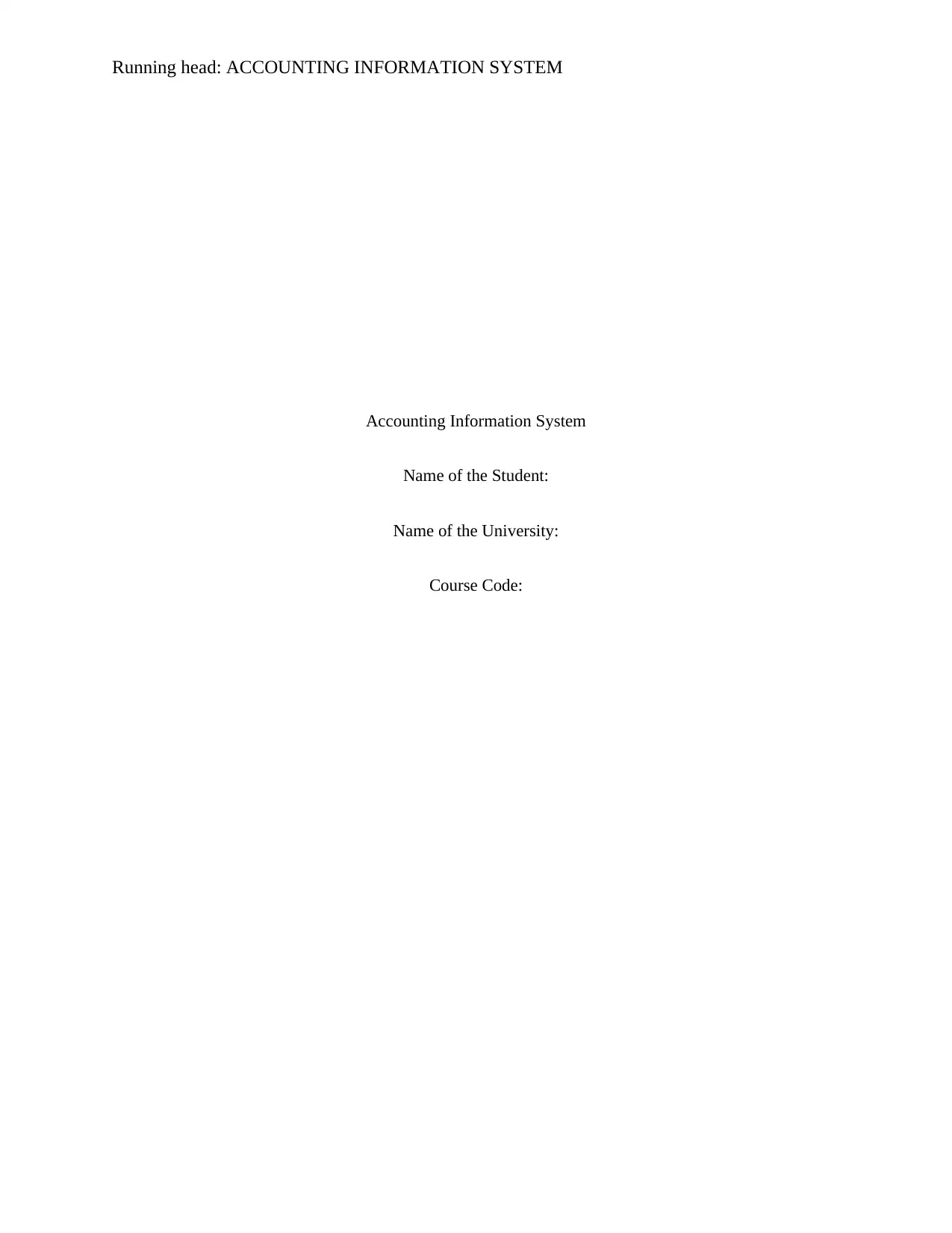
Running head: ACCOUNTING INFORMATION SYSTEM
Accounting Information System
Name of the Student:
Name of the University:
Course Code:
Accounting Information System
Name of the Student:
Name of the University:
Course Code:
Secure Best Marks with AI Grader
Need help grading? Try our AI Grader for instant feedback on your assignments.
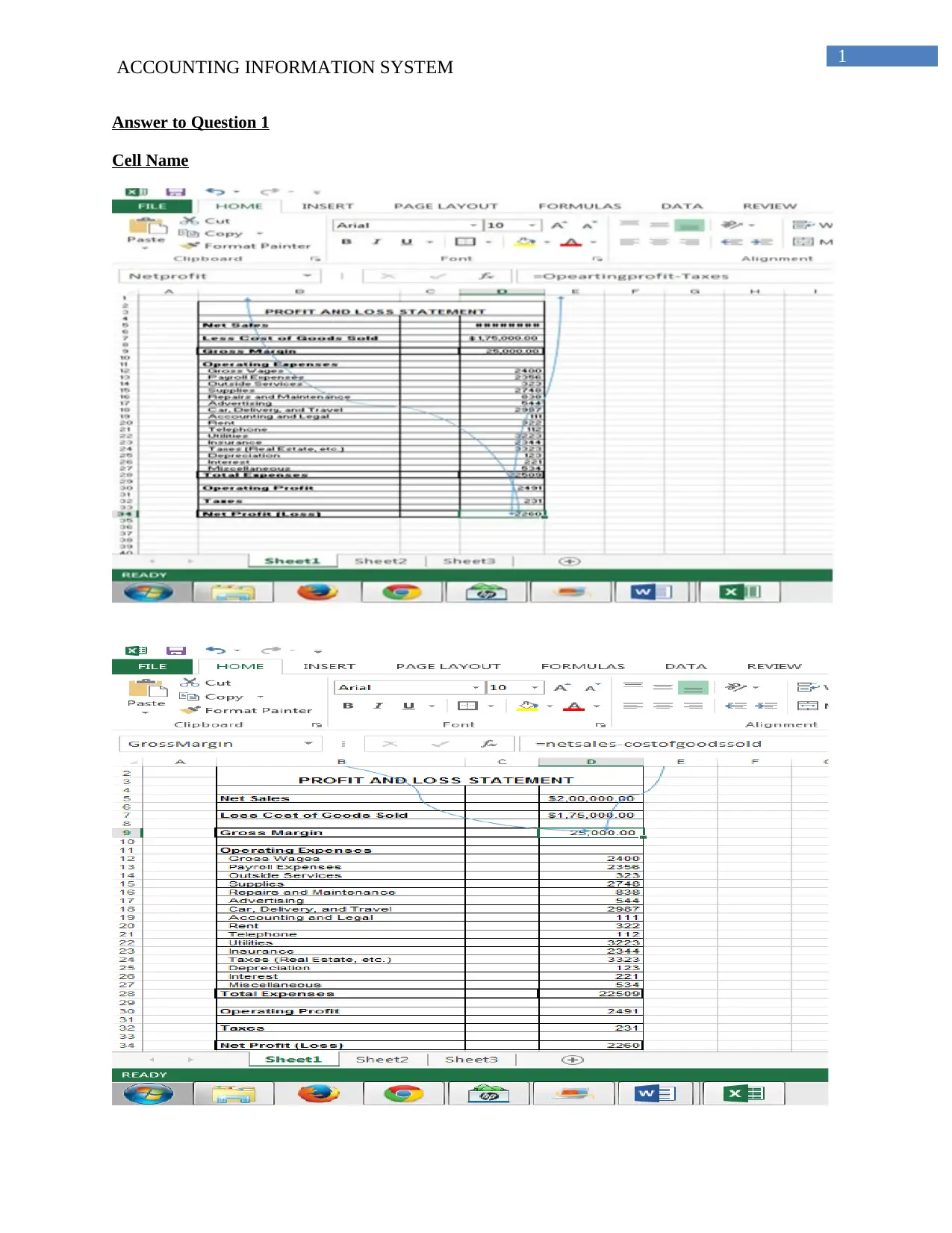
1
ACCOUNTING INFORMATION SYSTEM
Answer to Question 1
Cell Name
ACCOUNTING INFORMATION SYSTEM
Answer to Question 1
Cell Name
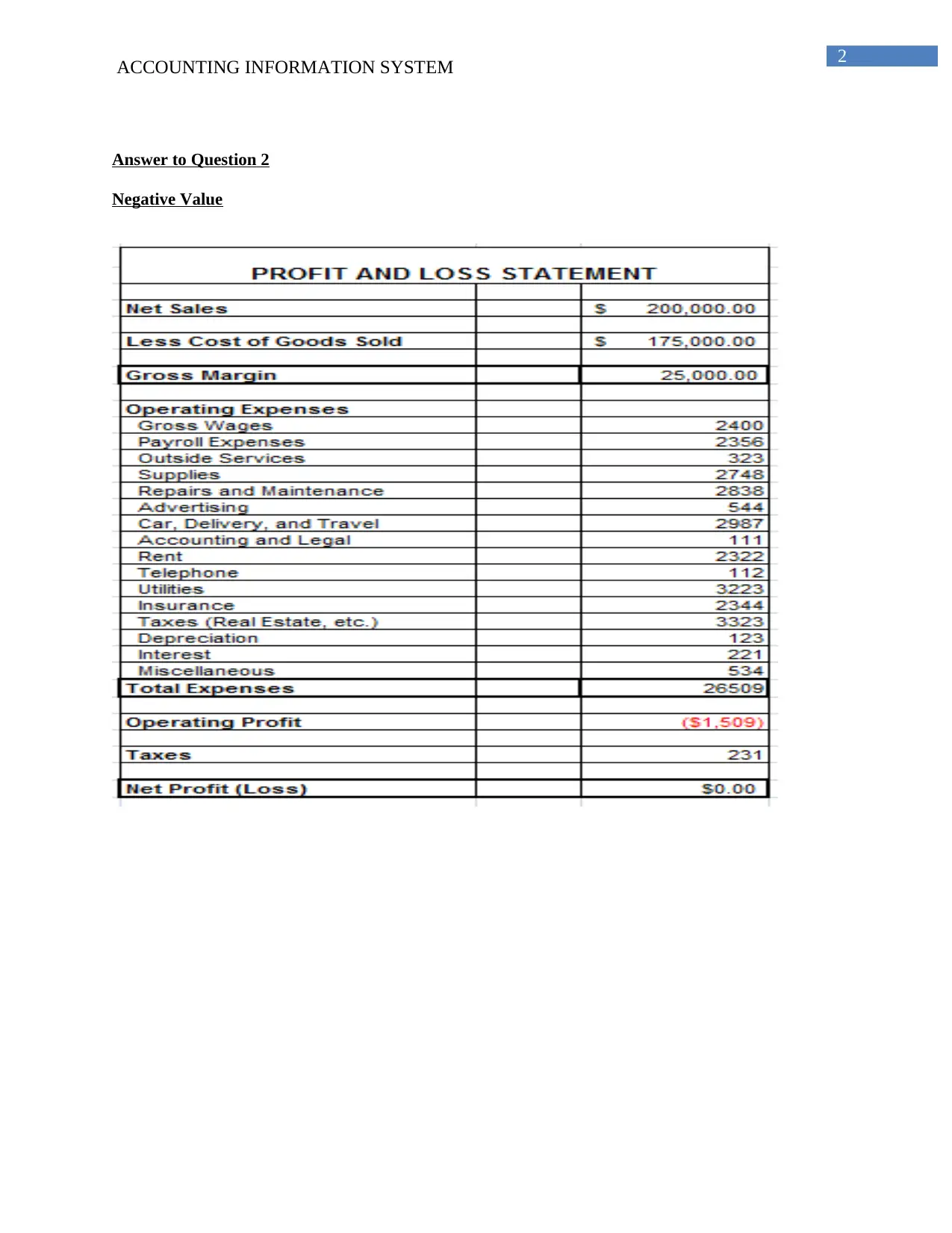
2
ACCOUNTING INFORMATION SYSTEM
Answer to Question 2
Negative Value
ACCOUNTING INFORMATION SYSTEM
Answer to Question 2
Negative Value
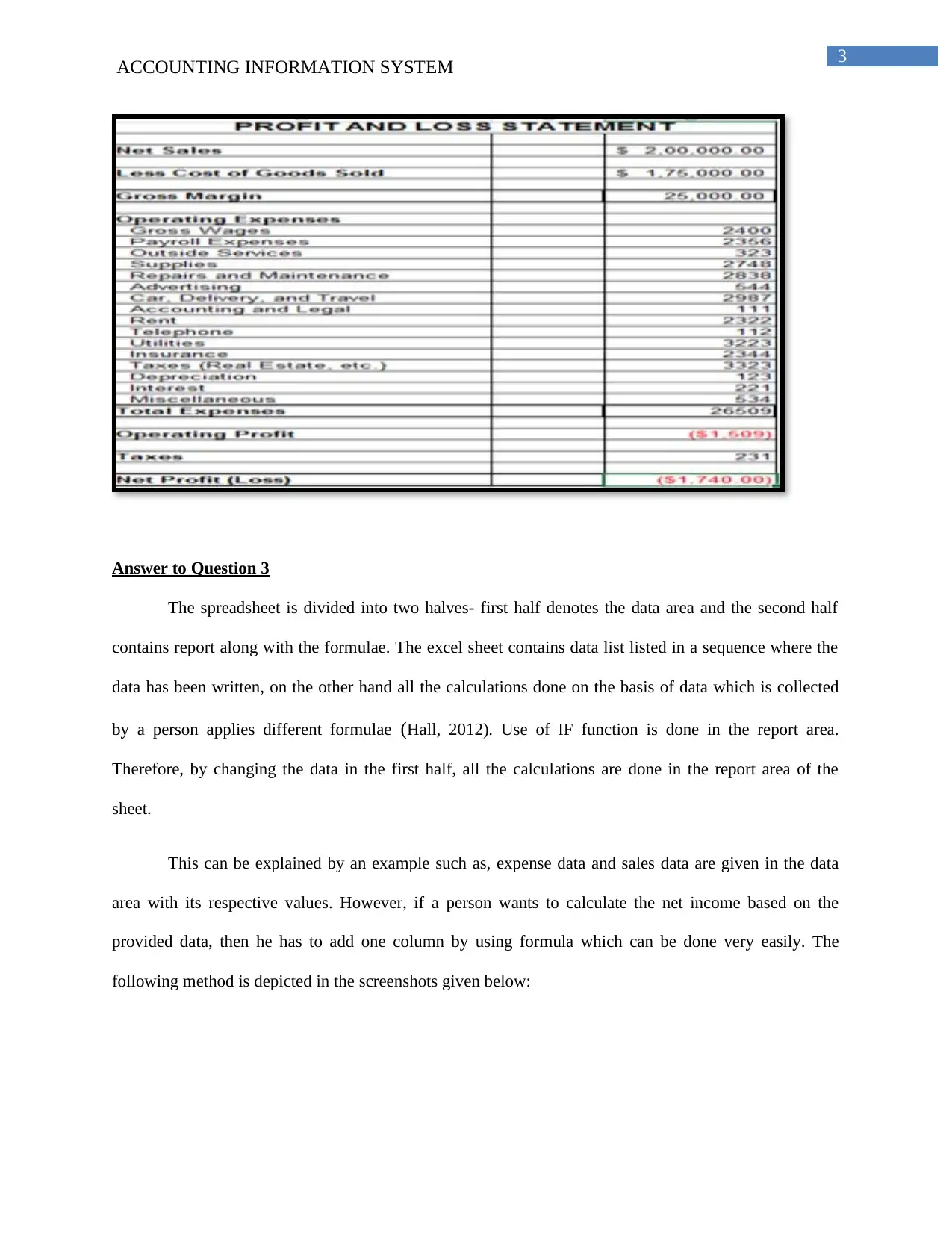
3
ACCOUNTING INFORMATION SYSTEM
Answer to Question 3
The spreadsheet is divided into two halves- first half denotes the data area and the second half
contains report along with the formulae. The excel sheet contains data list listed in a sequence where the
data has been written, on the other hand all the calculations done on the basis of data which is collected
by a person applies different formulae (Hall, 2012). Use of IF function is done in the report area.
Therefore, by changing the data in the first half, all the calculations are done in the report area of the
sheet.
This can be explained by an example such as, expense data and sales data are given in the data
area with its respective values. However, if a person wants to calculate the net income based on the
provided data, then he has to add one column by using formula which can be done very easily. The
following method is depicted in the screenshots given below:
ACCOUNTING INFORMATION SYSTEM
Answer to Question 3
The spreadsheet is divided into two halves- first half denotes the data area and the second half
contains report along with the formulae. The excel sheet contains data list listed in a sequence where the
data has been written, on the other hand all the calculations done on the basis of data which is collected
by a person applies different formulae (Hall, 2012). Use of IF function is done in the report area.
Therefore, by changing the data in the first half, all the calculations are done in the report area of the
sheet.
This can be explained by an example such as, expense data and sales data are given in the data
area with its respective values. However, if a person wants to calculate the net income based on the
provided data, then he has to add one column by using formula which can be done very easily. The
following method is depicted in the screenshots given below:
Secure Best Marks with AI Grader
Need help grading? Try our AI Grader for instant feedback on your assignments.
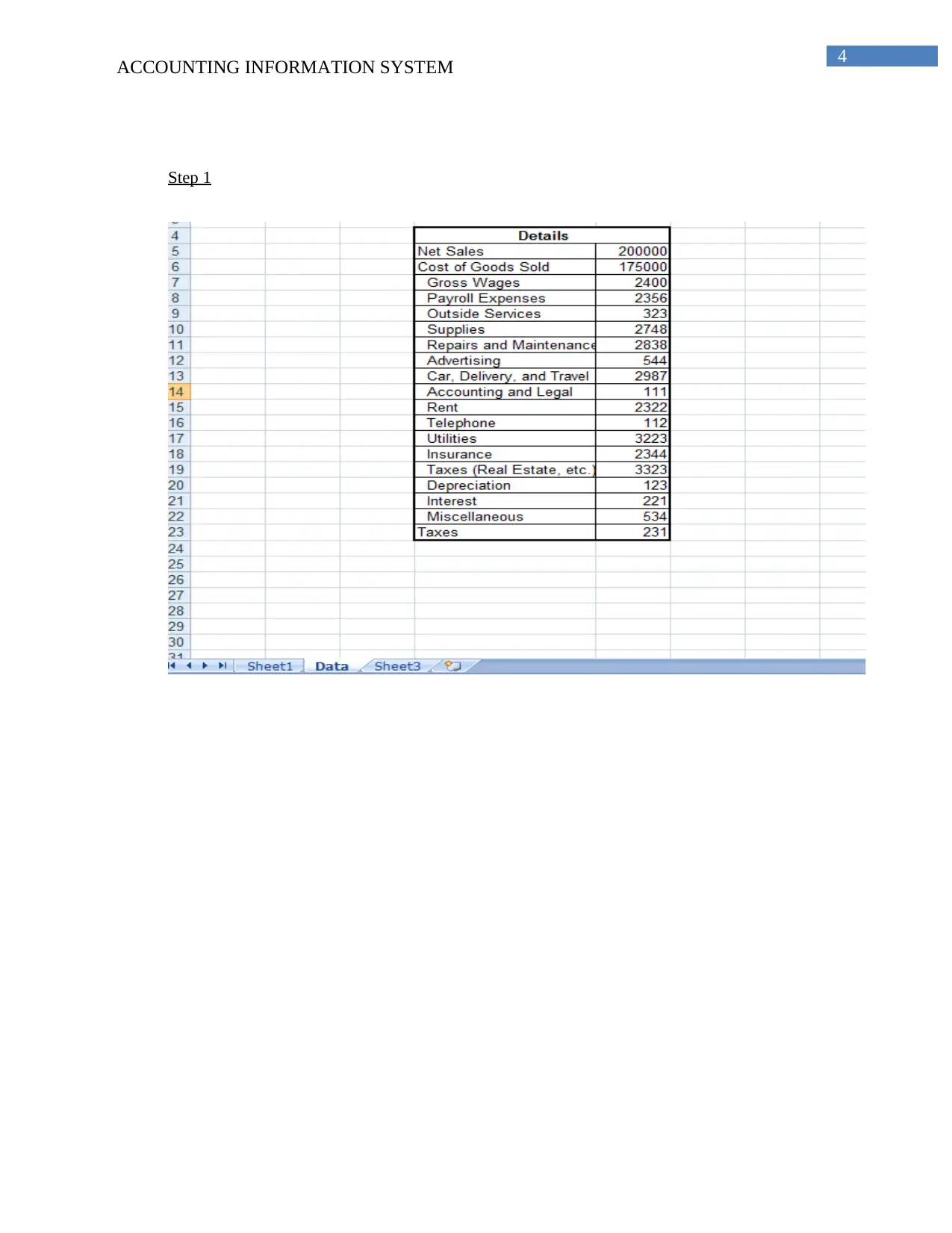
4
ACCOUNTING INFORMATION SYSTEM
Step 1
ACCOUNTING INFORMATION SYSTEM
Step 1
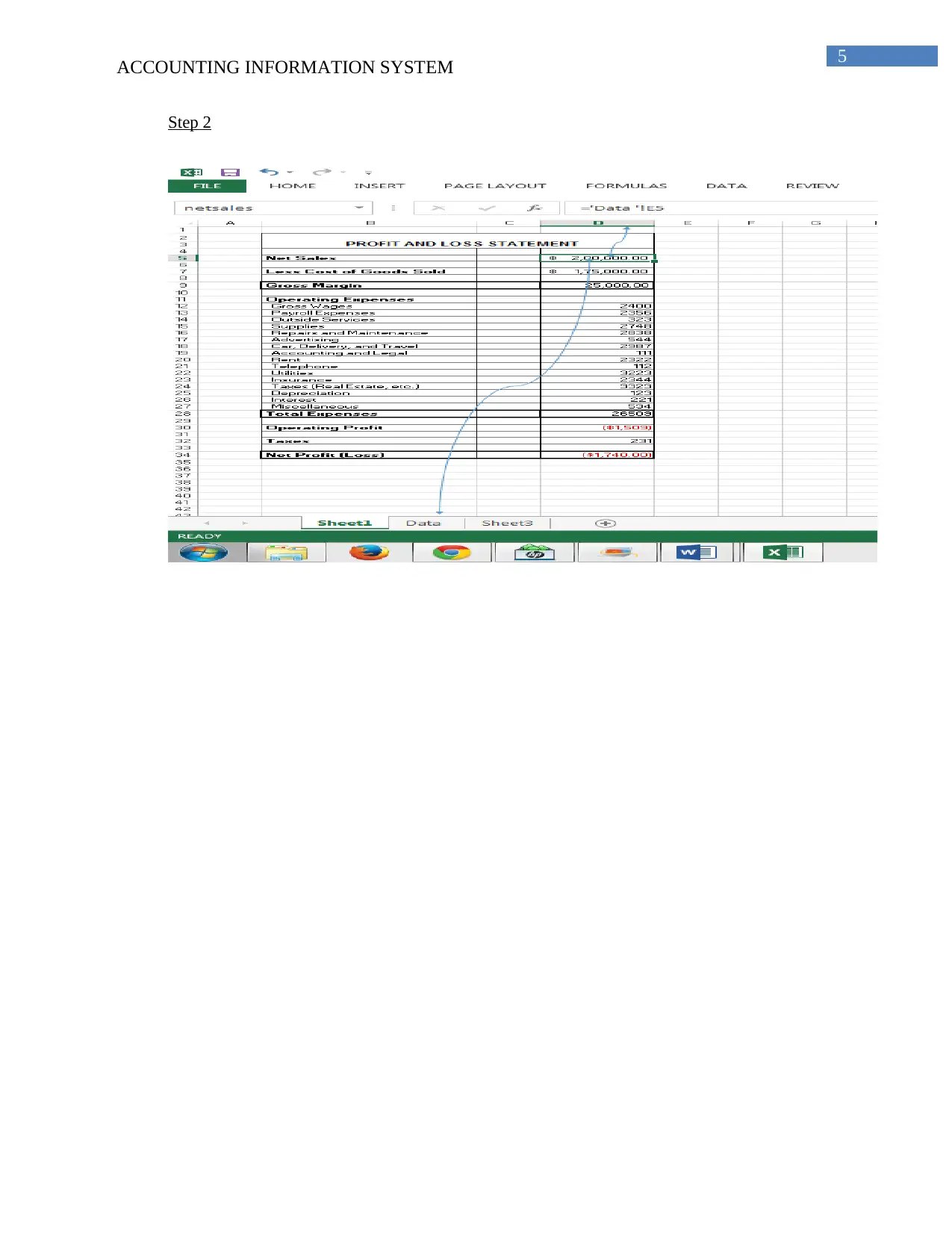
5
ACCOUNTING INFORMATION SYSTEM
Step 2
ACCOUNTING INFORMATION SYSTEM
Step 2
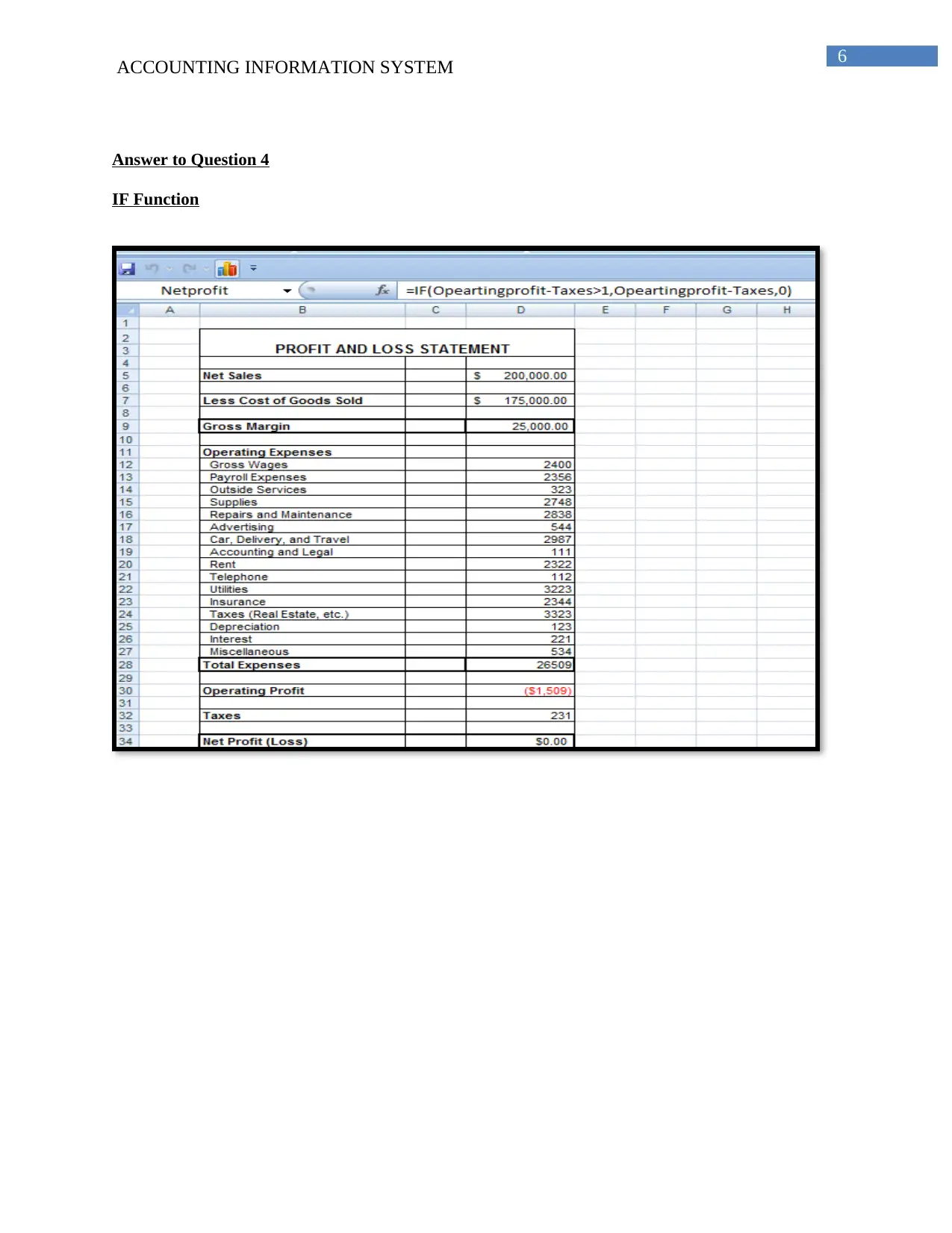
6
ACCOUNTING INFORMATION SYSTEM
Answer to Question 4
IF Function
ACCOUNTING INFORMATION SYSTEM
Answer to Question 4
IF Function
Paraphrase This Document
Need a fresh take? Get an instant paraphrase of this document with our AI Paraphraser
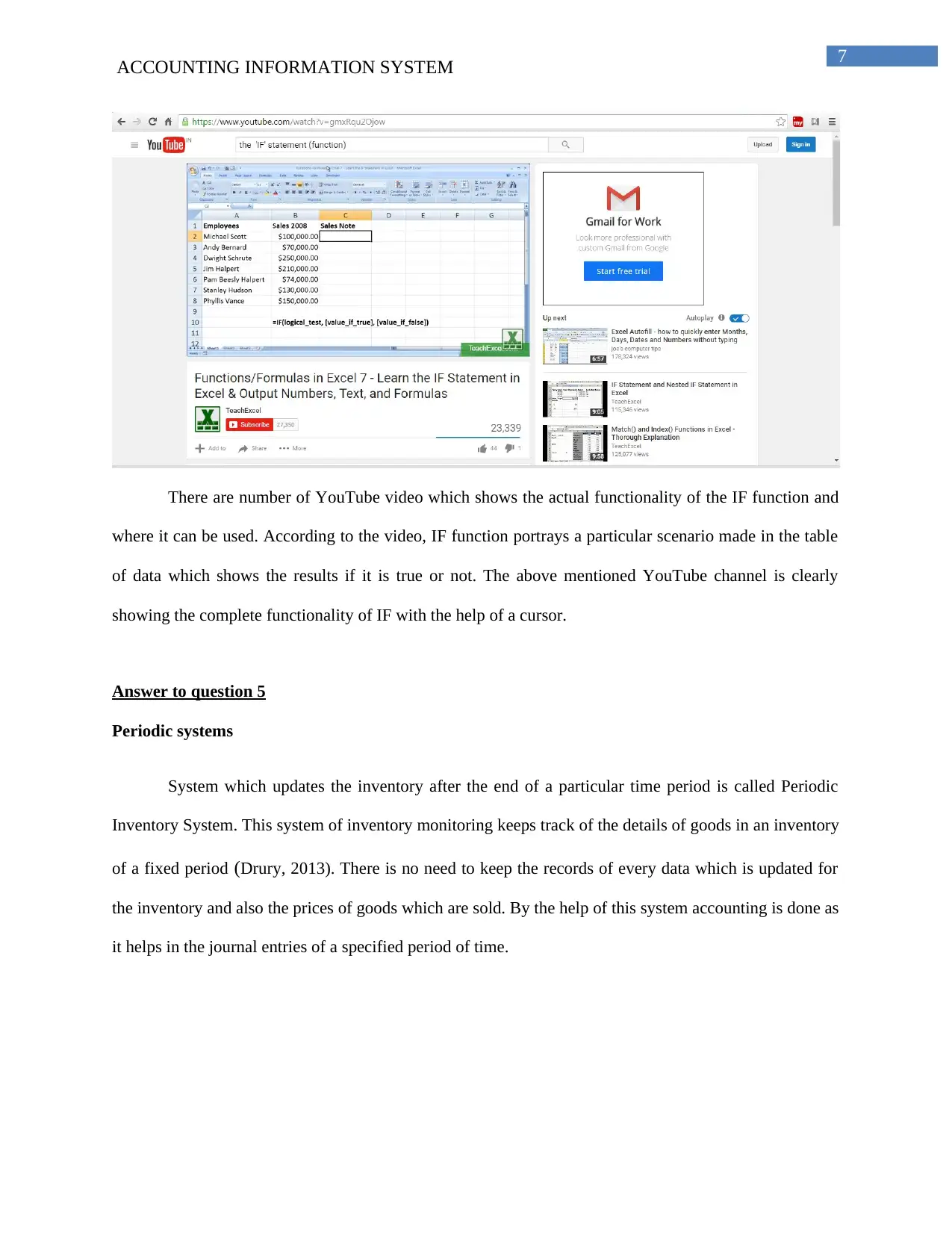
7
ACCOUNTING INFORMATION SYSTEM
There are number of YouTube video which shows the actual functionality of the IF function and
where it can be used. According to the video, IF function portrays a particular scenario made in the table
of data which shows the results if it is true or not. The above mentioned YouTube channel is clearly
showing the complete functionality of IF with the help of a cursor.
Answer to question 5
Periodic systems
System which updates the inventory after the end of a particular time period is called Periodic
Inventory System. This system of inventory monitoring keeps track of the details of goods in an inventory
of a fixed period (Drury, 2013). There is no need to keep the records of every data which is updated for
the inventory and also the prices of goods which are sold. By the help of this system accounting is done as
it helps in the journal entries of a specified period of time.
ACCOUNTING INFORMATION SYSTEM
There are number of YouTube video which shows the actual functionality of the IF function and
where it can be used. According to the video, IF function portrays a particular scenario made in the table
of data which shows the results if it is true or not. The above mentioned YouTube channel is clearly
showing the complete functionality of IF with the help of a cursor.
Answer to question 5
Periodic systems
System which updates the inventory after the end of a particular time period is called Periodic
Inventory System. This system of inventory monitoring keeps track of the details of goods in an inventory
of a fixed period (Drury, 2013). There is no need to keep the records of every data which is updated for
the inventory and also the prices of goods which are sold. By the help of this system accounting is done as
it helps in the journal entries of a specified period of time.
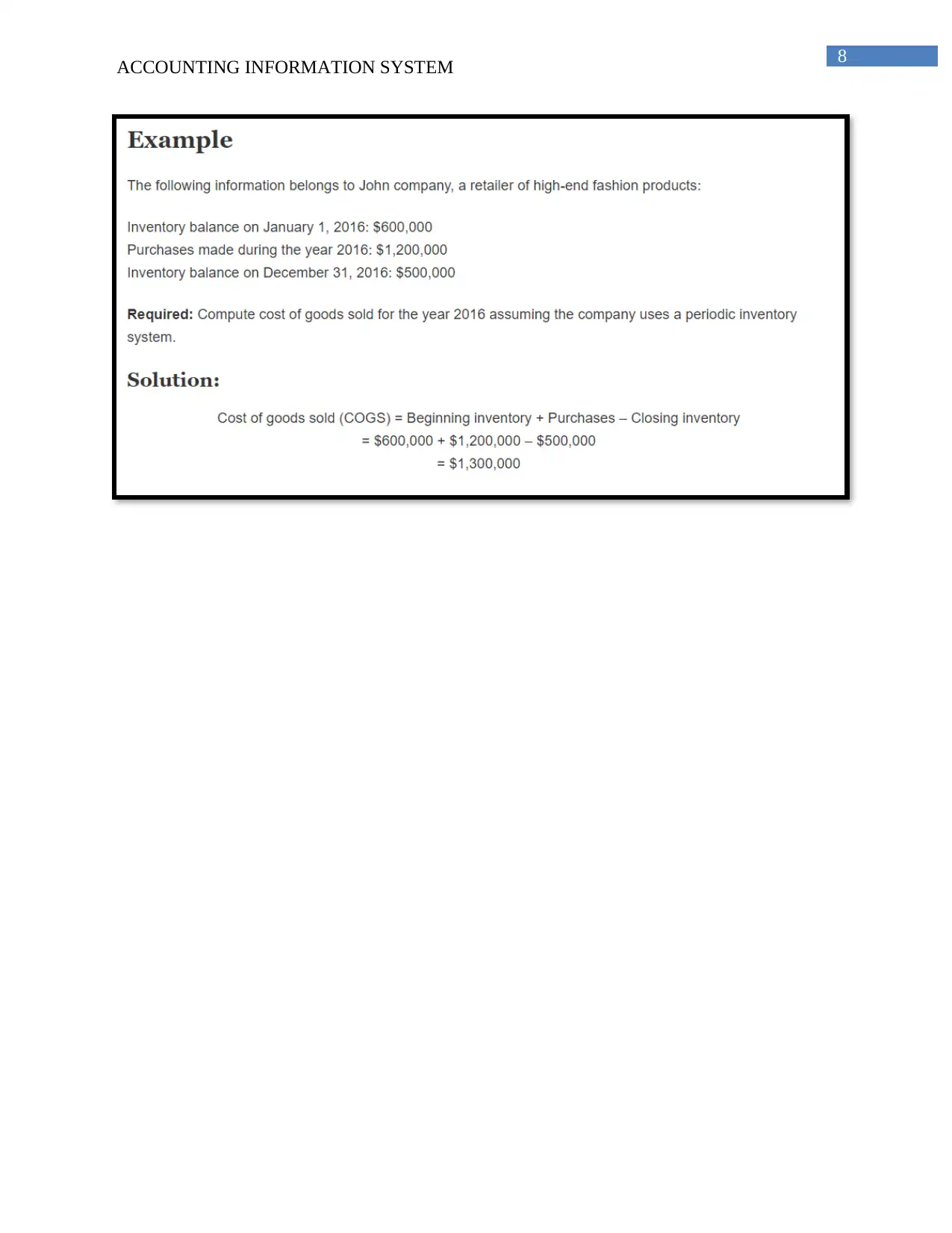
8
ACCOUNTING INFORMATION SYSTEM
ACCOUNTING INFORMATION SYSTEM
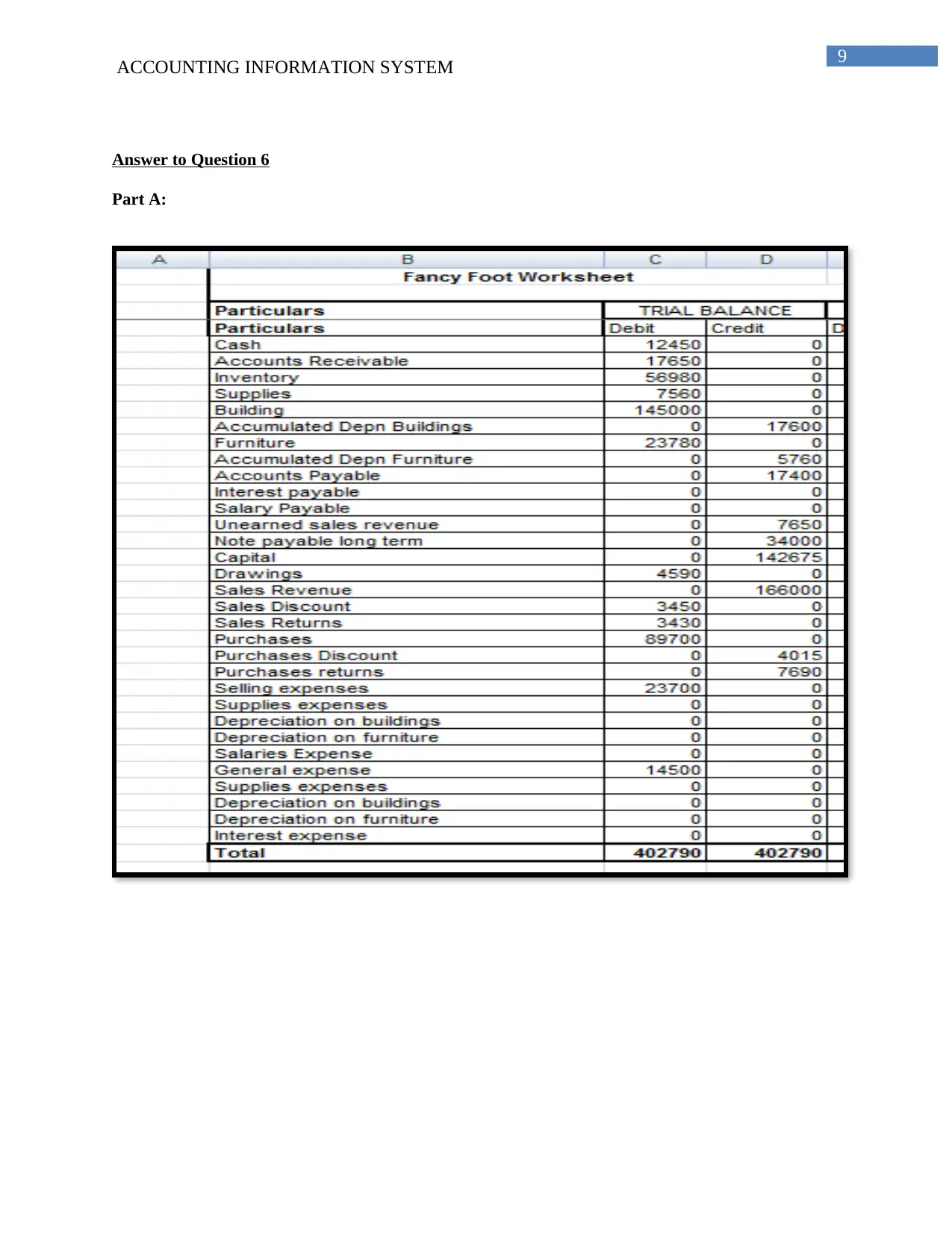
9
ACCOUNTING INFORMATION SYSTEM
Answer to Question 6
Part A:
ACCOUNTING INFORMATION SYSTEM
Answer to Question 6
Part A:
Secure Best Marks with AI Grader
Need help grading? Try our AI Grader for instant feedback on your assignments.
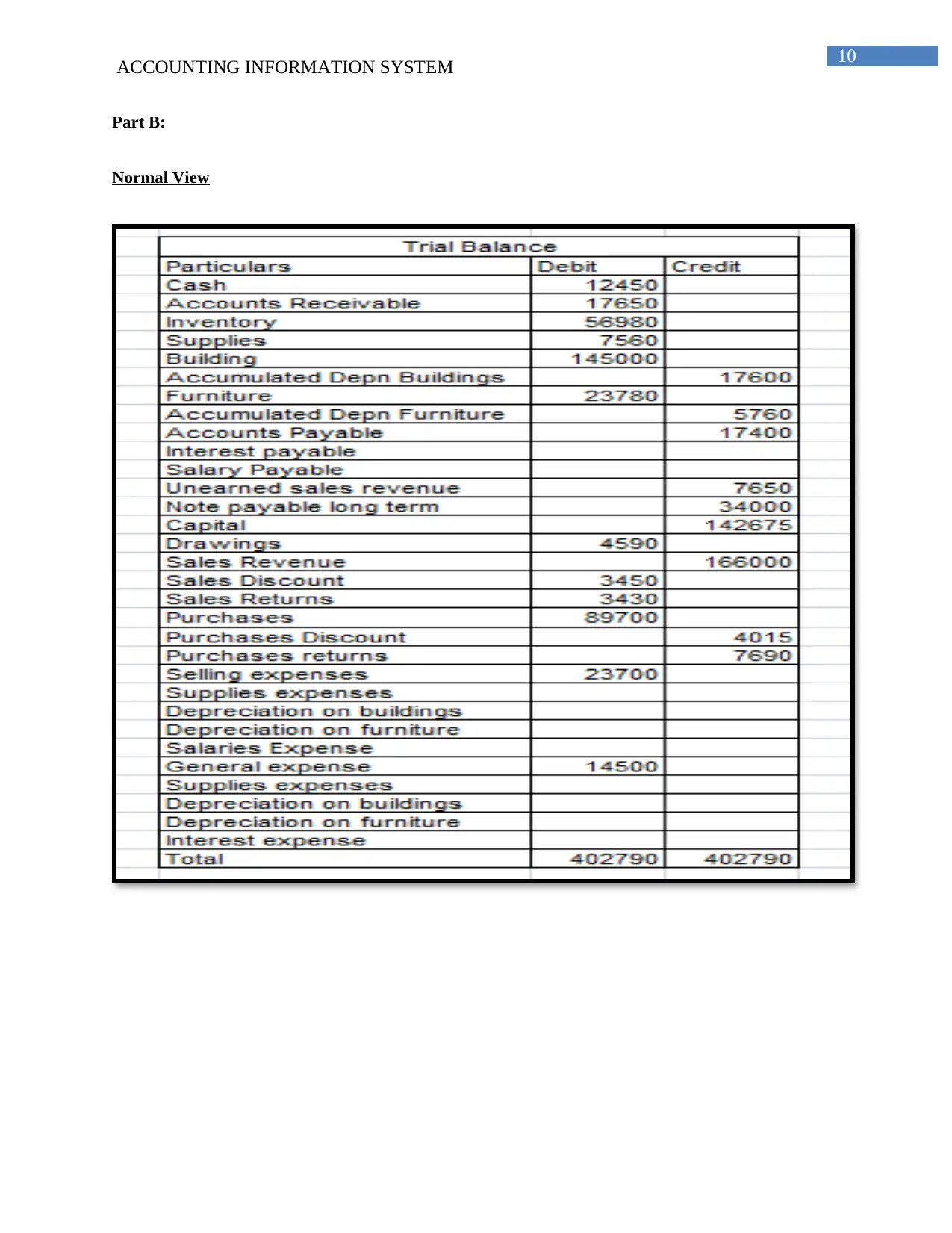
10
ACCOUNTING INFORMATION SYSTEM
Part B:
Normal View
ACCOUNTING INFORMATION SYSTEM
Part B:
Normal View
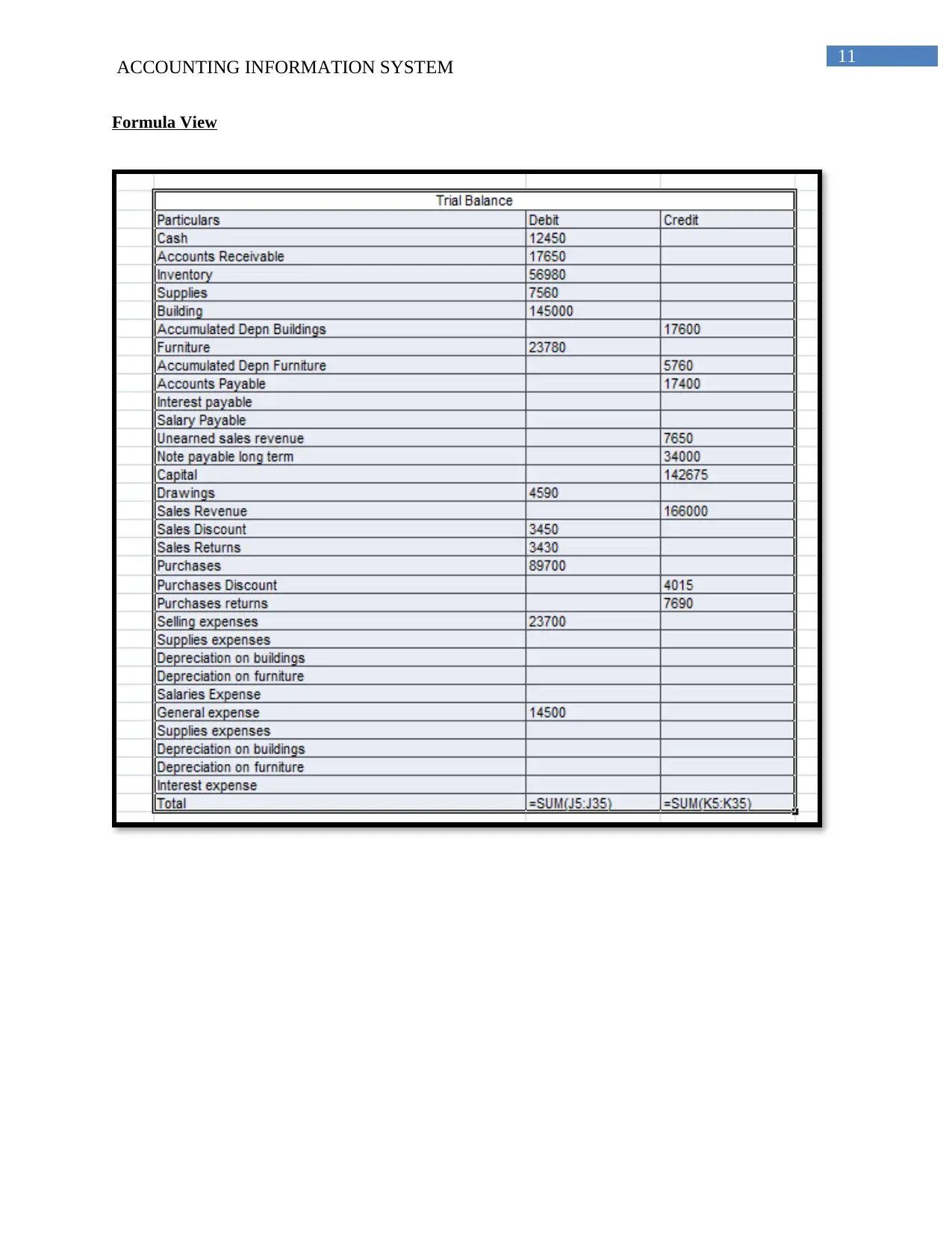
11
ACCOUNTING INFORMATION SYSTEM
Formula View
ACCOUNTING INFORMATION SYSTEM
Formula View
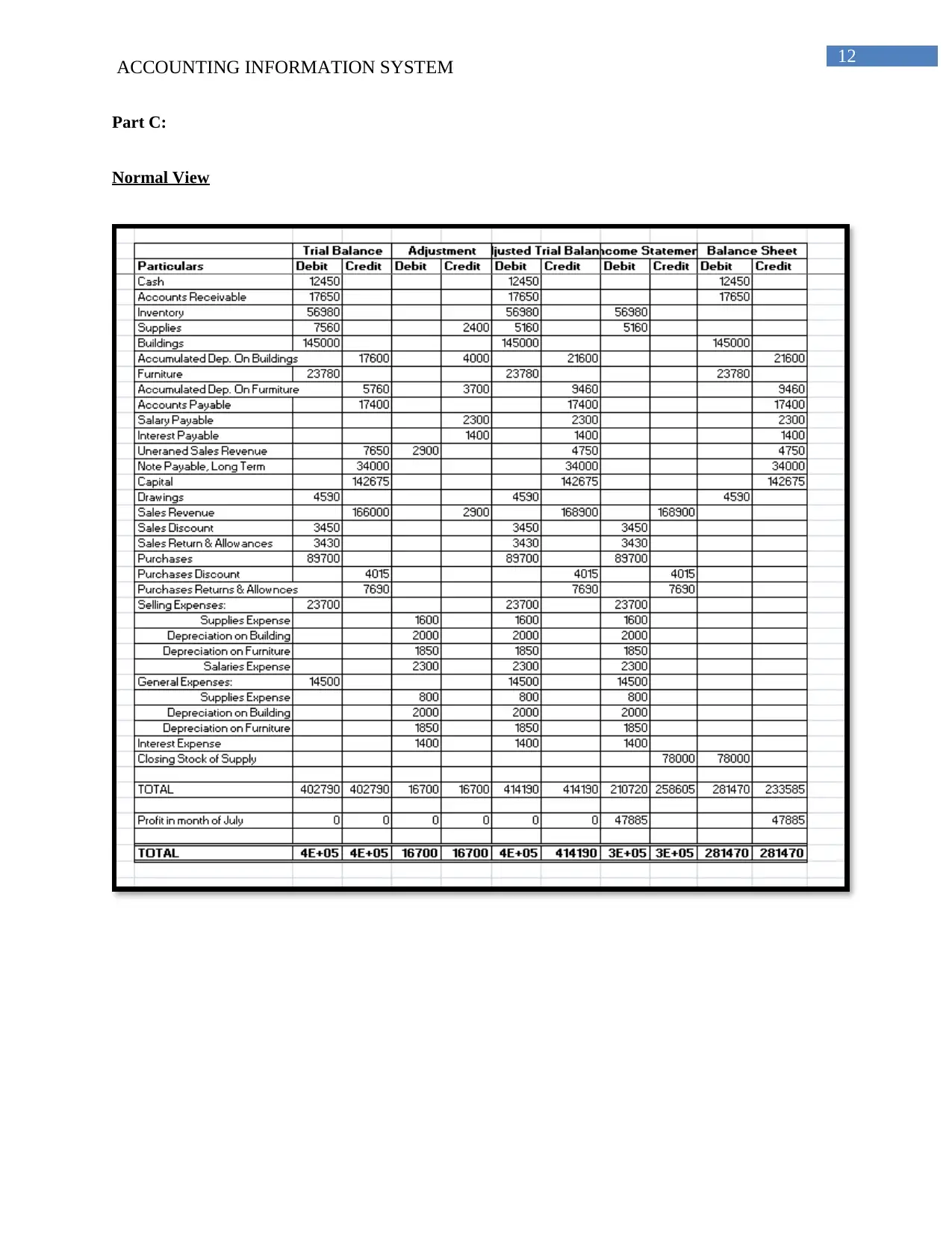
12
ACCOUNTING INFORMATION SYSTEM
Part C:
Normal View
ACCOUNTING INFORMATION SYSTEM
Part C:
Normal View
Paraphrase This Document
Need a fresh take? Get an instant paraphrase of this document with our AI Paraphraser
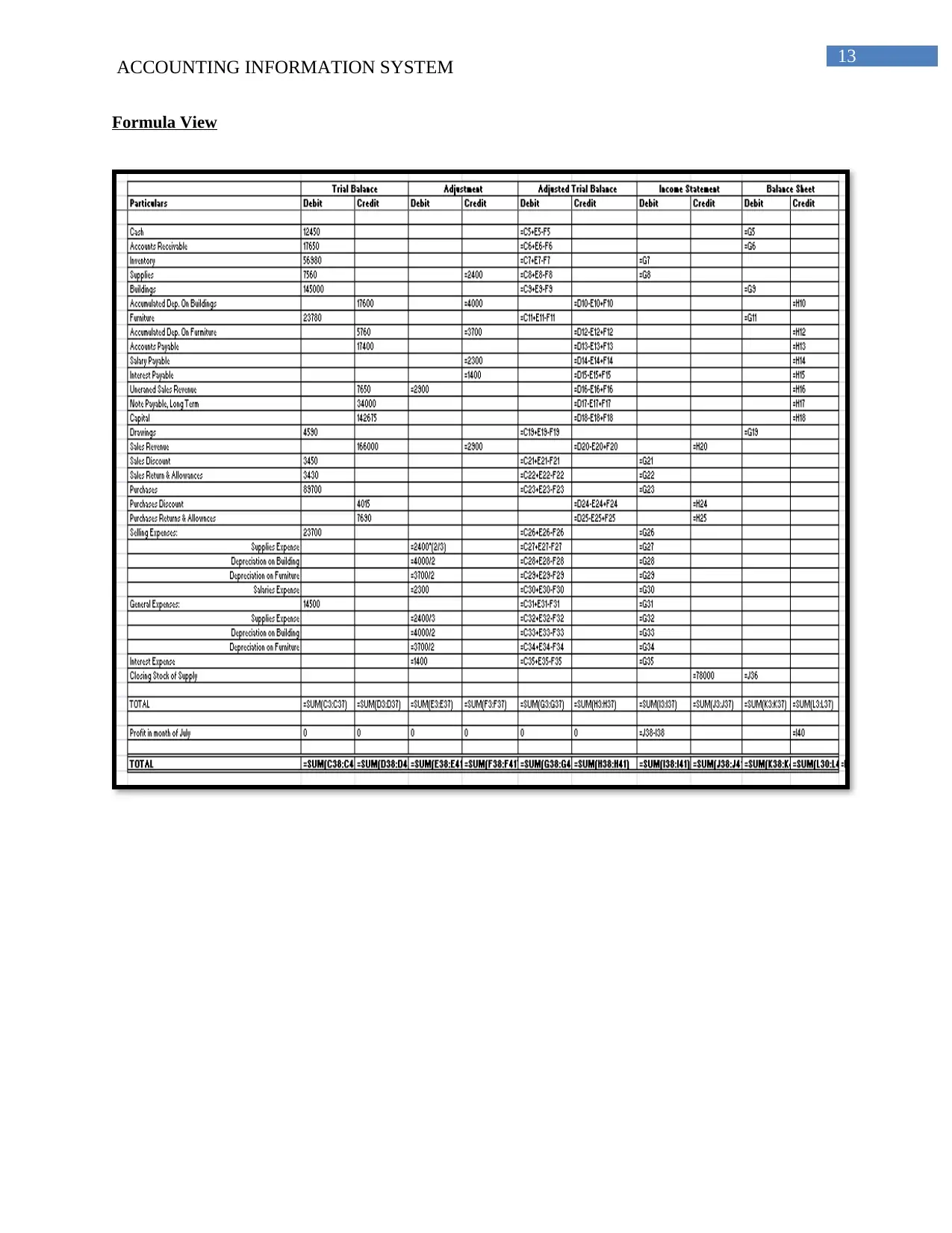
13
ACCOUNTING INFORMATION SYSTEM
Formula View
ACCOUNTING INFORMATION SYSTEM
Formula View
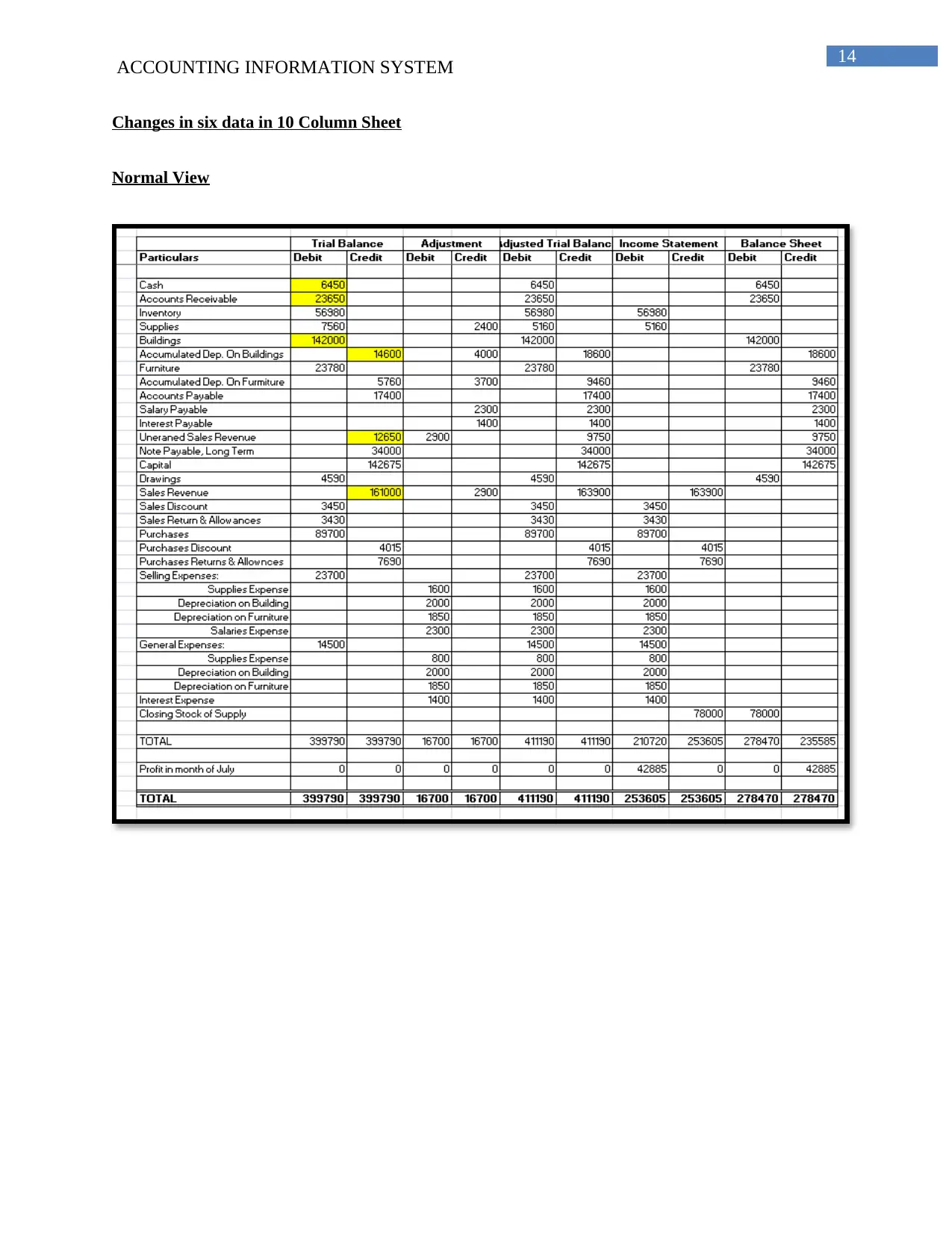
14
ACCOUNTING INFORMATION SYSTEM
Changes in six data in 10 Column Sheet
Normal View
ACCOUNTING INFORMATION SYSTEM
Changes in six data in 10 Column Sheet
Normal View
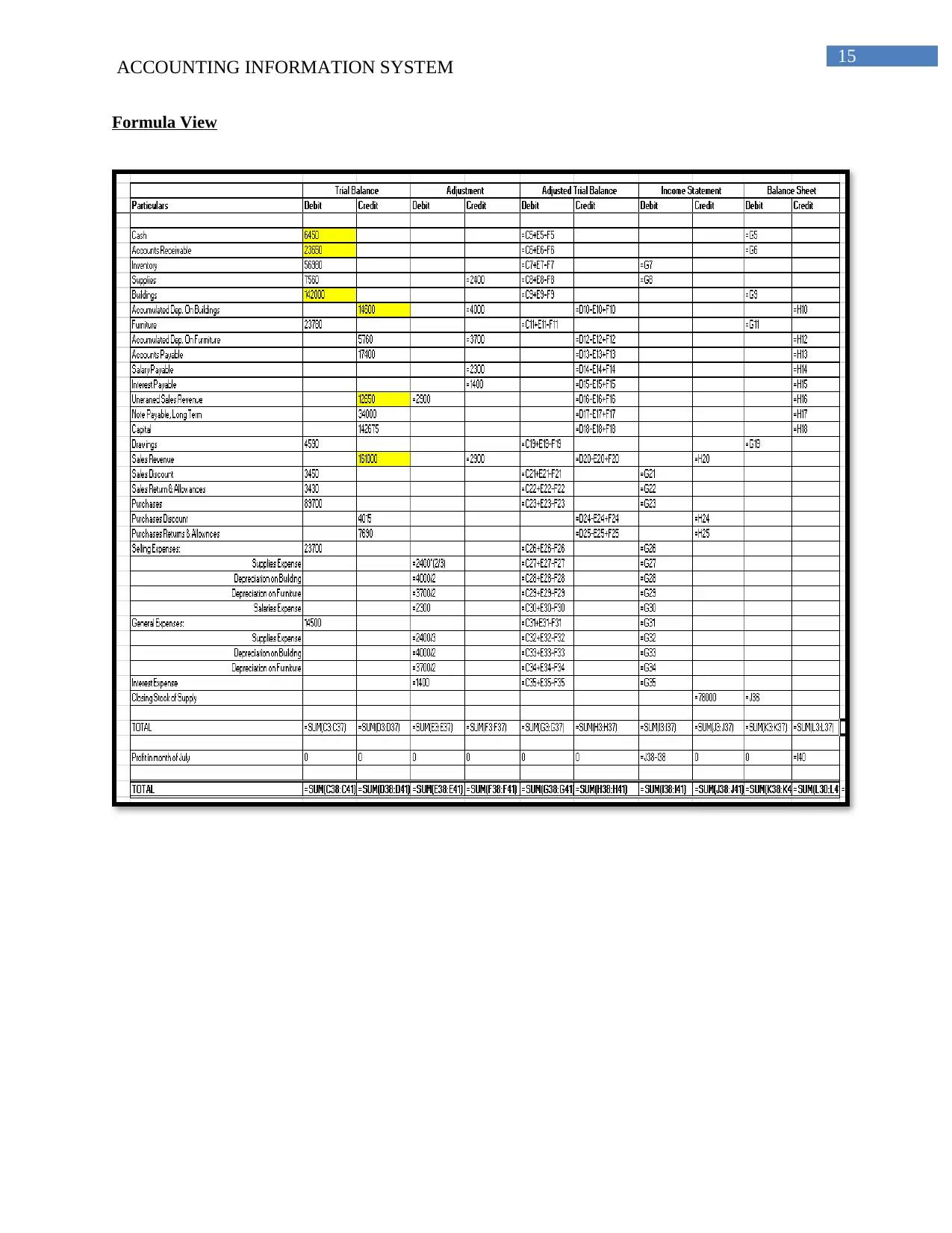
15
ACCOUNTING INFORMATION SYSTEM
Formula View
ACCOUNTING INFORMATION SYSTEM
Formula View
Secure Best Marks with AI Grader
Need help grading? Try our AI Grader for instant feedback on your assignments.
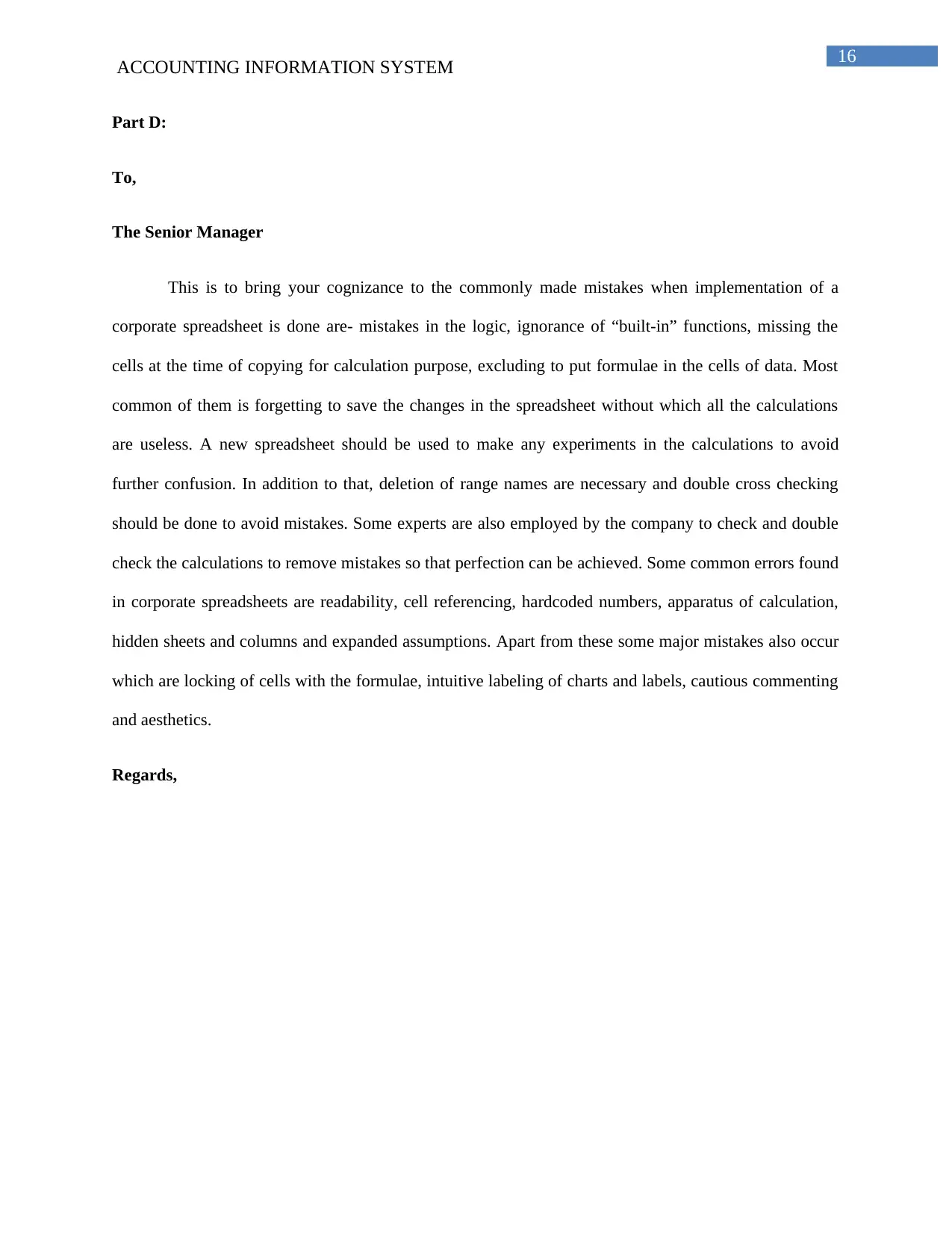
16
ACCOUNTING INFORMATION SYSTEM
Part D:
To,
The Senior Manager
This is to bring your cognizance to the commonly made mistakes when implementation of a
corporate spreadsheet is done are- mistakes in the logic, ignorance of “built-in” functions, missing the
cells at the time of copying for calculation purpose, excluding to put formulae in the cells of data. Most
common of them is forgetting to save the changes in the spreadsheet without which all the calculations
are useless. A new spreadsheet should be used to make any experiments in the calculations to avoid
further confusion. In addition to that, deletion of range names are necessary and double cross checking
should be done to avoid mistakes. Some experts are also employed by the company to check and double
check the calculations to remove mistakes so that perfection can be achieved. Some common errors found
in corporate spreadsheets are readability, cell referencing, hardcoded numbers, apparatus of calculation,
hidden sheets and columns and expanded assumptions. Apart from these some major mistakes also occur
which are locking of cells with the formulae, intuitive labeling of charts and labels, cautious commenting
and aesthetics.
Regards,
ACCOUNTING INFORMATION SYSTEM
Part D:
To,
The Senior Manager
This is to bring your cognizance to the commonly made mistakes when implementation of a
corporate spreadsheet is done are- mistakes in the logic, ignorance of “built-in” functions, missing the
cells at the time of copying for calculation purpose, excluding to put formulae in the cells of data. Most
common of them is forgetting to save the changes in the spreadsheet without which all the calculations
are useless. A new spreadsheet should be used to make any experiments in the calculations to avoid
further confusion. In addition to that, deletion of range names are necessary and double cross checking
should be done to avoid mistakes. Some experts are also employed by the company to check and double
check the calculations to remove mistakes so that perfection can be achieved. Some common errors found
in corporate spreadsheets are readability, cell referencing, hardcoded numbers, apparatus of calculation,
hidden sheets and columns and expanded assumptions. Apart from these some major mistakes also occur
which are locking of cells with the formulae, intuitive labeling of charts and labels, cautious commenting
and aesthetics.
Regards,
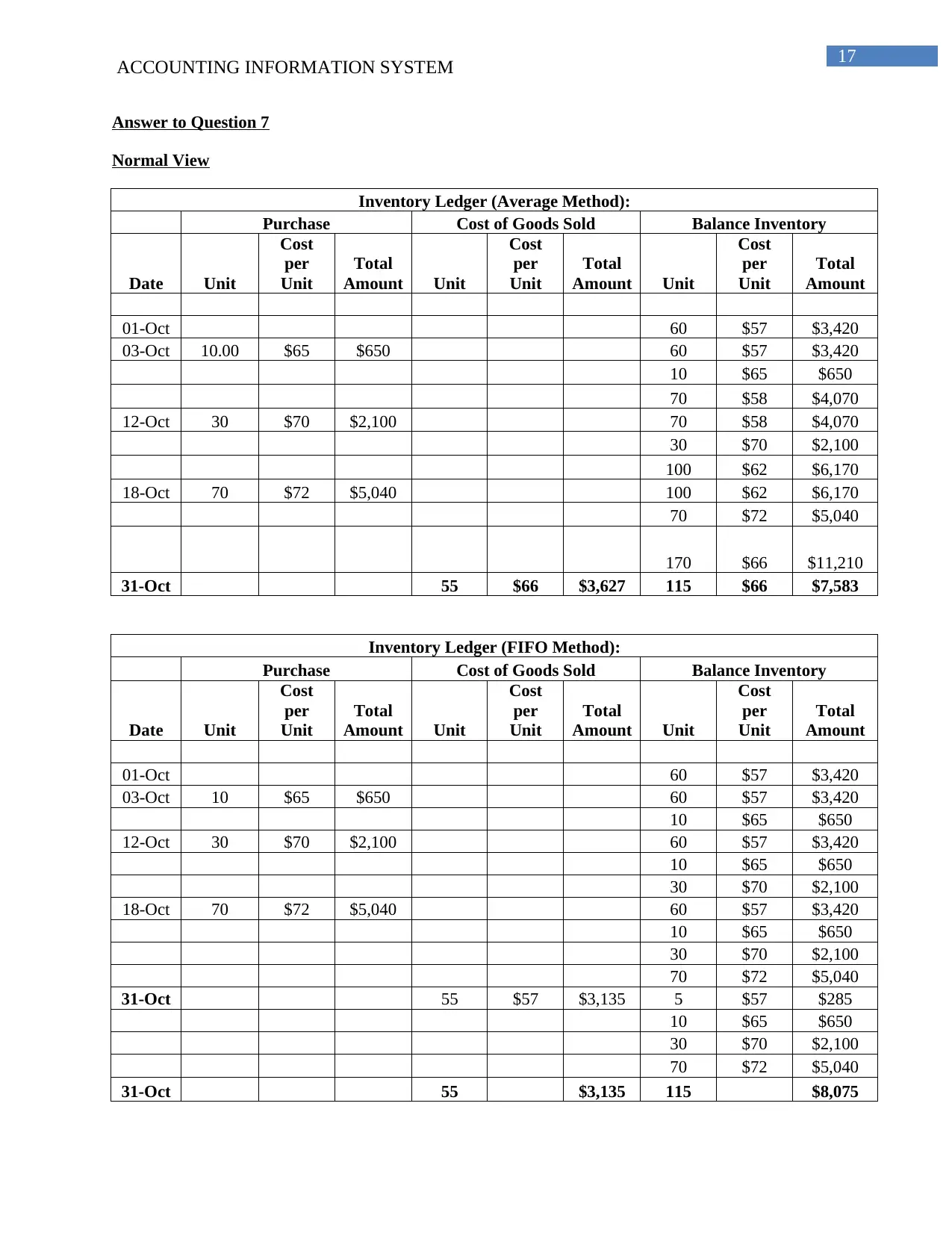
17
ACCOUNTING INFORMATION SYSTEM
Answer to Question 7
Normal View
Inventory Ledger (Average Method):
Purchase Cost of Goods Sold Balance Inventory
Date Unit
Cost
per
Unit
Total
Amount Unit
Cost
per
Unit
Total
Amount Unit
Cost
per
Unit
Total
Amount
01-Oct 60 $57 $3,420
03-Oct 10.00 $65 $650 60 $57 $3,420
10 $65 $650
70 $58 $4,070
12-Oct 30 $70 $2,100 70 $58 $4,070
30 $70 $2,100
100 $62 $6,170
18-Oct 70 $72 $5,040 100 $62 $6,170
70 $72 $5,040
170 $66 $11,210
31-Oct 55 $66 $3,627 115 $66 $7,583
Inventory Ledger (FIFO Method):
Purchase Cost of Goods Sold Balance Inventory
Date Unit
Cost
per
Unit
Total
Amount Unit
Cost
per
Unit
Total
Amount Unit
Cost
per
Unit
Total
Amount
01-Oct 60 $57 $3,420
03-Oct 10 $65 $650 60 $57 $3,420
10 $65 $650
12-Oct 30 $70 $2,100 60 $57 $3,420
10 $65 $650
30 $70 $2,100
18-Oct 70 $72 $5,040 60 $57 $3,420
10 $65 $650
30 $70 $2,100
70 $72 $5,040
31-Oct 55 $57 $3,135 5 $57 $285
10 $65 $650
30 $70 $2,100
70 $72 $5,040
31-Oct 55 $3,135 115 $8,075
ACCOUNTING INFORMATION SYSTEM
Answer to Question 7
Normal View
Inventory Ledger (Average Method):
Purchase Cost of Goods Sold Balance Inventory
Date Unit
Cost
per
Unit
Total
Amount Unit
Cost
per
Unit
Total
Amount Unit
Cost
per
Unit
Total
Amount
01-Oct 60 $57 $3,420
03-Oct 10.00 $65 $650 60 $57 $3,420
10 $65 $650
70 $58 $4,070
12-Oct 30 $70 $2,100 70 $58 $4,070
30 $70 $2,100
100 $62 $6,170
18-Oct 70 $72 $5,040 100 $62 $6,170
70 $72 $5,040
170 $66 $11,210
31-Oct 55 $66 $3,627 115 $66 $7,583
Inventory Ledger (FIFO Method):
Purchase Cost of Goods Sold Balance Inventory
Date Unit
Cost
per
Unit
Total
Amount Unit
Cost
per
Unit
Total
Amount Unit
Cost
per
Unit
Total
Amount
01-Oct 60 $57 $3,420
03-Oct 10 $65 $650 60 $57 $3,420
10 $65 $650
12-Oct 30 $70 $2,100 60 $57 $3,420
10 $65 $650
30 $70 $2,100
18-Oct 70 $72 $5,040 60 $57 $3,420
10 $65 $650
30 $70 $2,100
70 $72 $5,040
31-Oct 55 $57 $3,135 5 $57 $285
10 $65 $650
30 $70 $2,100
70 $72 $5,040
31-Oct 55 $3,135 115 $8,075
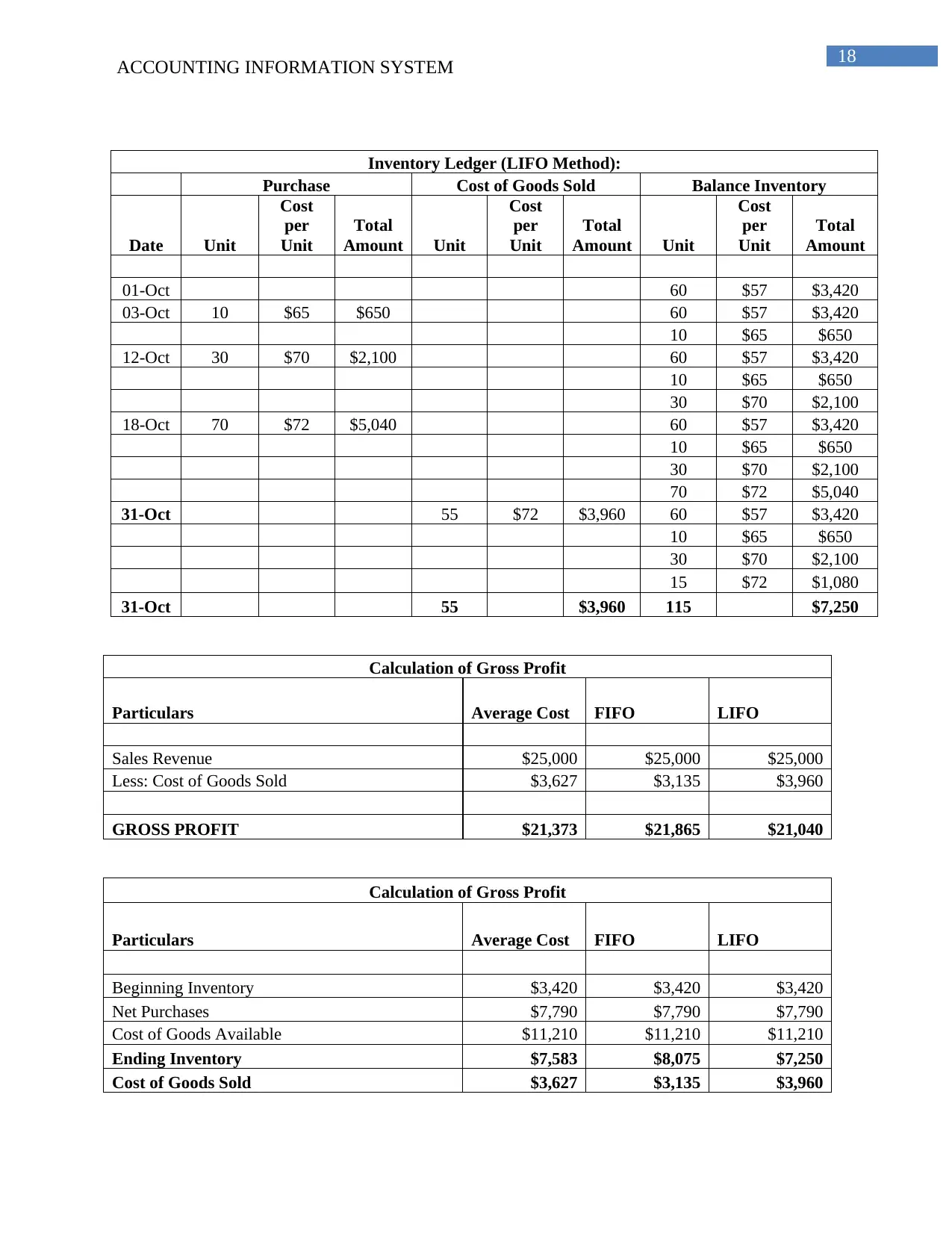
18
ACCOUNTING INFORMATION SYSTEM
Inventory Ledger (LIFO Method):
Purchase Cost of Goods Sold Balance Inventory
Date Unit
Cost
per
Unit
Total
Amount Unit
Cost
per
Unit
Total
Amount Unit
Cost
per
Unit
Total
Amount
01-Oct 60 $57 $3,420
03-Oct 10 $65 $650 60 $57 $3,420
10 $65 $650
12-Oct 30 $70 $2,100 60 $57 $3,420
10 $65 $650
30 $70 $2,100
18-Oct 70 $72 $5,040 60 $57 $3,420
10 $65 $650
30 $70 $2,100
70 $72 $5,040
31-Oct 55 $72 $3,960 60 $57 $3,420
10 $65 $650
30 $70 $2,100
15 $72 $1,080
31-Oct 55 $3,960 115 $7,250
Calculation of Gross Profit
Particulars Average Cost FIFO LIFO
Sales Revenue $25,000 $25,000 $25,000
Less: Cost of Goods Sold $3,627 $3,135 $3,960
GROSS PROFIT $21,373 $21,865 $21,040
Calculation of Gross Profit
Particulars Average Cost FIFO LIFO
Beginning Inventory $3,420 $3,420 $3,420
Net Purchases $7,790 $7,790 $7,790
Cost of Goods Available $11,210 $11,210 $11,210
Ending Inventory $7,583 $8,075 $7,250
Cost of Goods Sold $3,627 $3,135 $3,960
ACCOUNTING INFORMATION SYSTEM
Inventory Ledger (LIFO Method):
Purchase Cost of Goods Sold Balance Inventory
Date Unit
Cost
per
Unit
Total
Amount Unit
Cost
per
Unit
Total
Amount Unit
Cost
per
Unit
Total
Amount
01-Oct 60 $57 $3,420
03-Oct 10 $65 $650 60 $57 $3,420
10 $65 $650
12-Oct 30 $70 $2,100 60 $57 $3,420
10 $65 $650
30 $70 $2,100
18-Oct 70 $72 $5,040 60 $57 $3,420
10 $65 $650
30 $70 $2,100
70 $72 $5,040
31-Oct 55 $72 $3,960 60 $57 $3,420
10 $65 $650
30 $70 $2,100
15 $72 $1,080
31-Oct 55 $3,960 115 $7,250
Calculation of Gross Profit
Particulars Average Cost FIFO LIFO
Sales Revenue $25,000 $25,000 $25,000
Less: Cost of Goods Sold $3,627 $3,135 $3,960
GROSS PROFIT $21,373 $21,865 $21,040
Calculation of Gross Profit
Particulars Average Cost FIFO LIFO
Beginning Inventory $3,420 $3,420 $3,420
Net Purchases $7,790 $7,790 $7,790
Cost of Goods Available $11,210 $11,210 $11,210
Ending Inventory $7,583 $8,075 $7,250
Cost of Goods Sold $3,627 $3,135 $3,960
Paraphrase This Document
Need a fresh take? Get an instant paraphrase of this document with our AI Paraphraser
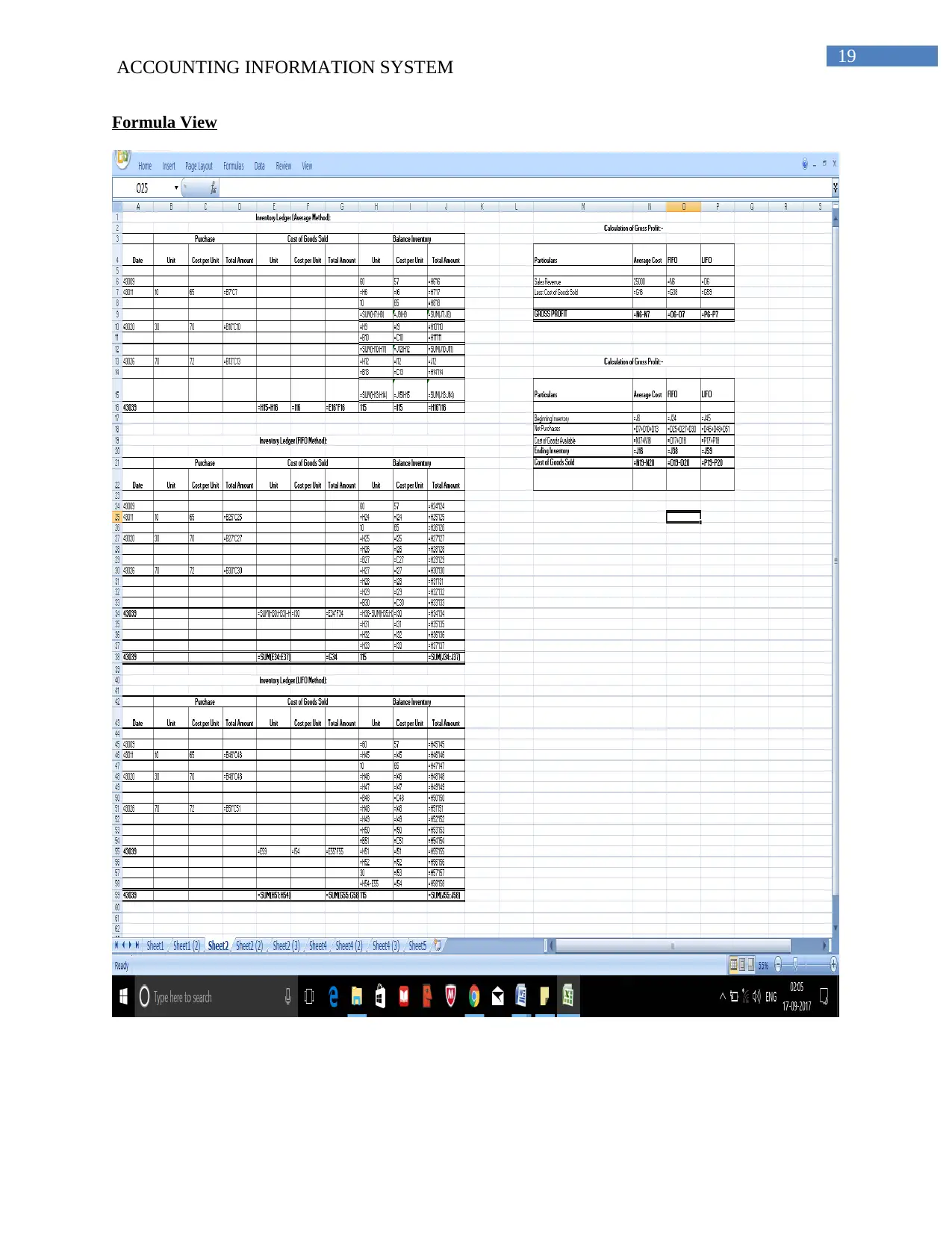
19
ACCOUNTING INFORMATION SYSTEM
Formula View
ACCOUNTING INFORMATION SYSTEM
Formula View
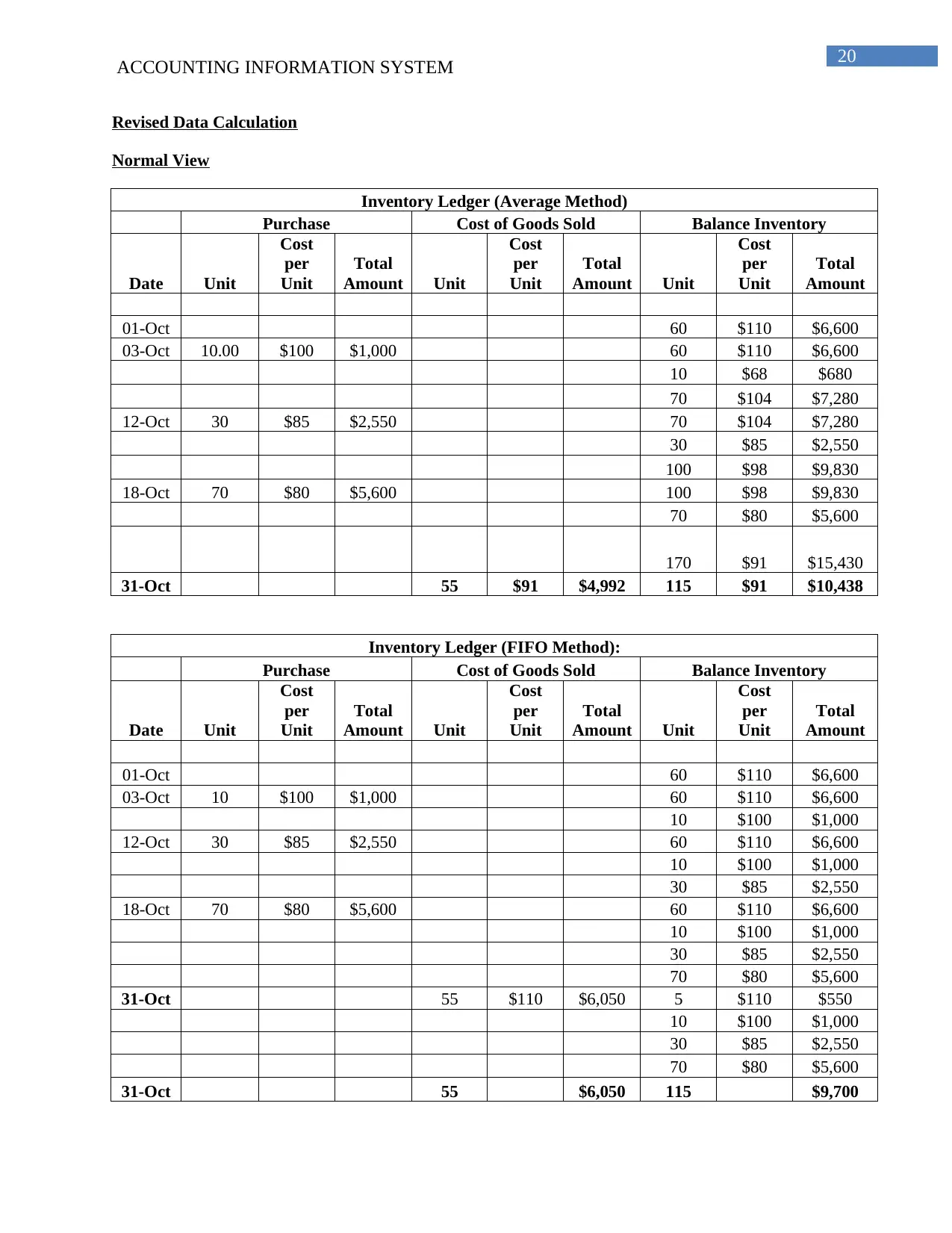
20
ACCOUNTING INFORMATION SYSTEM
Revised Data Calculation
Normal View
Inventory Ledger (Average Method)
Purchase Cost of Goods Sold Balance Inventory
Date Unit
Cost
per
Unit
Total
Amount Unit
Cost
per
Unit
Total
Amount Unit
Cost
per
Unit
Total
Amount
01-Oct 60 $110 $6,600
03-Oct 10.00 $100 $1,000 60 $110 $6,600
10 $68 $680
70 $104 $7,280
12-Oct 30 $85 $2,550 70 $104 $7,280
30 $85 $2,550
100 $98 $9,830
18-Oct 70 $80 $5,600 100 $98 $9,830
70 $80 $5,600
170 $91 $15,430
31-Oct 55 $91 $4,992 115 $91 $10,438
Inventory Ledger (FIFO Method):
Purchase Cost of Goods Sold Balance Inventory
Date Unit
Cost
per
Unit
Total
Amount Unit
Cost
per
Unit
Total
Amount Unit
Cost
per
Unit
Total
Amount
01-Oct 60 $110 $6,600
03-Oct 10 $100 $1,000 60 $110 $6,600
10 $100 $1,000
12-Oct 30 $85 $2,550 60 $110 $6,600
10 $100 $1,000
30 $85 $2,550
18-Oct 70 $80 $5,600 60 $110 $6,600
10 $100 $1,000
30 $85 $2,550
70 $80 $5,600
31-Oct 55 $110 $6,050 5 $110 $550
10 $100 $1,000
30 $85 $2,550
70 $80 $5,600
31-Oct 55 $6,050 115 $9,700
ACCOUNTING INFORMATION SYSTEM
Revised Data Calculation
Normal View
Inventory Ledger (Average Method)
Purchase Cost of Goods Sold Balance Inventory
Date Unit
Cost
per
Unit
Total
Amount Unit
Cost
per
Unit
Total
Amount Unit
Cost
per
Unit
Total
Amount
01-Oct 60 $110 $6,600
03-Oct 10.00 $100 $1,000 60 $110 $6,600
10 $68 $680
70 $104 $7,280
12-Oct 30 $85 $2,550 70 $104 $7,280
30 $85 $2,550
100 $98 $9,830
18-Oct 70 $80 $5,600 100 $98 $9,830
70 $80 $5,600
170 $91 $15,430
31-Oct 55 $91 $4,992 115 $91 $10,438
Inventory Ledger (FIFO Method):
Purchase Cost of Goods Sold Balance Inventory
Date Unit
Cost
per
Unit
Total
Amount Unit
Cost
per
Unit
Total
Amount Unit
Cost
per
Unit
Total
Amount
01-Oct 60 $110 $6,600
03-Oct 10 $100 $1,000 60 $110 $6,600
10 $100 $1,000
12-Oct 30 $85 $2,550 60 $110 $6,600
10 $100 $1,000
30 $85 $2,550
18-Oct 70 $80 $5,600 60 $110 $6,600
10 $100 $1,000
30 $85 $2,550
70 $80 $5,600
31-Oct 55 $110 $6,050 5 $110 $550
10 $100 $1,000
30 $85 $2,550
70 $80 $5,600
31-Oct 55 $6,050 115 $9,700
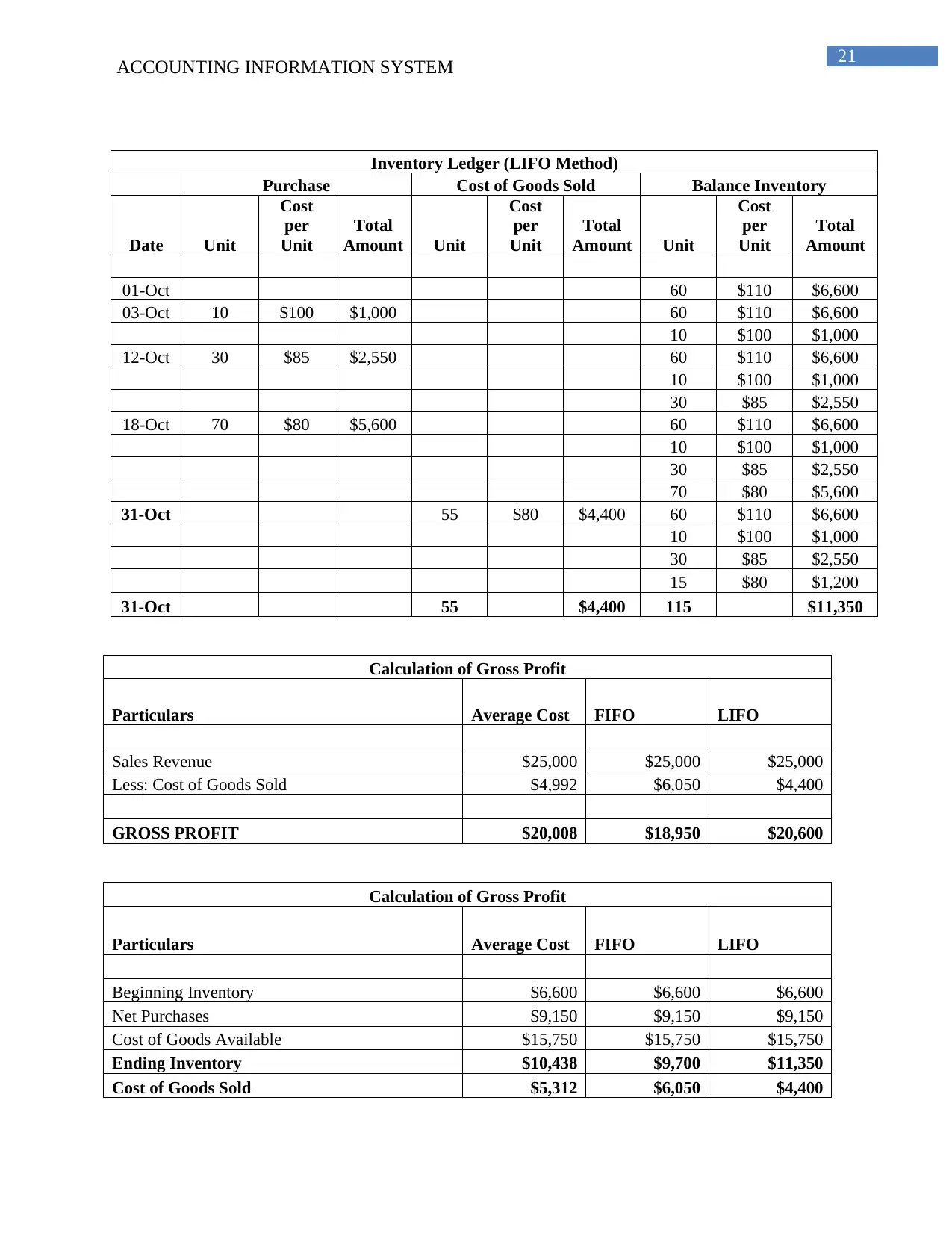
21
ACCOUNTING INFORMATION SYSTEM
Inventory Ledger (LIFO Method)
Purchase Cost of Goods Sold Balance Inventory
Date Unit
Cost
per
Unit
Total
Amount Unit
Cost
per
Unit
Total
Amount Unit
Cost
per
Unit
Total
Amount
01-Oct 60 $110 $6,600
03-Oct 10 $100 $1,000 60 $110 $6,600
10 $100 $1,000
12-Oct 30 $85 $2,550 60 $110 $6,600
10 $100 $1,000
30 $85 $2,550
18-Oct 70 $80 $5,600 60 $110 $6,600
10 $100 $1,000
30 $85 $2,550
70 $80 $5,600
31-Oct 55 $80 $4,400 60 $110 $6,600
10 $100 $1,000
30 $85 $2,550
15 $80 $1,200
31-Oct 55 $4,400 115 $11,350
Calculation of Gross Profit
Particulars Average Cost FIFO LIFO
Sales Revenue $25,000 $25,000 $25,000
Less: Cost of Goods Sold $4,992 $6,050 $4,400
GROSS PROFIT $20,008 $18,950 $20,600
Calculation of Gross Profit
Particulars Average Cost FIFO LIFO
Beginning Inventory $6,600 $6,600 $6,600
Net Purchases $9,150 $9,150 $9,150
Cost of Goods Available $15,750 $15,750 $15,750
Ending Inventory $10,438 $9,700 $11,350
Cost of Goods Sold $5,312 $6,050 $4,400
ACCOUNTING INFORMATION SYSTEM
Inventory Ledger (LIFO Method)
Purchase Cost of Goods Sold Balance Inventory
Date Unit
Cost
per
Unit
Total
Amount Unit
Cost
per
Unit
Total
Amount Unit
Cost
per
Unit
Total
Amount
01-Oct 60 $110 $6,600
03-Oct 10 $100 $1,000 60 $110 $6,600
10 $100 $1,000
12-Oct 30 $85 $2,550 60 $110 $6,600
10 $100 $1,000
30 $85 $2,550
18-Oct 70 $80 $5,600 60 $110 $6,600
10 $100 $1,000
30 $85 $2,550
70 $80 $5,600
31-Oct 55 $80 $4,400 60 $110 $6,600
10 $100 $1,000
30 $85 $2,550
15 $80 $1,200
31-Oct 55 $4,400 115 $11,350
Calculation of Gross Profit
Particulars Average Cost FIFO LIFO
Sales Revenue $25,000 $25,000 $25,000
Less: Cost of Goods Sold $4,992 $6,050 $4,400
GROSS PROFIT $20,008 $18,950 $20,600
Calculation of Gross Profit
Particulars Average Cost FIFO LIFO
Beginning Inventory $6,600 $6,600 $6,600
Net Purchases $9,150 $9,150 $9,150
Cost of Goods Available $15,750 $15,750 $15,750
Ending Inventory $10,438 $9,700 $11,350
Cost of Goods Sold $5,312 $6,050 $4,400
Secure Best Marks with AI Grader
Need help grading? Try our AI Grader for instant feedback on your assignments.

22
ACCOUNTING INFORMATION SYSTEM
ACCOUNTING INFORMATION SYSTEM
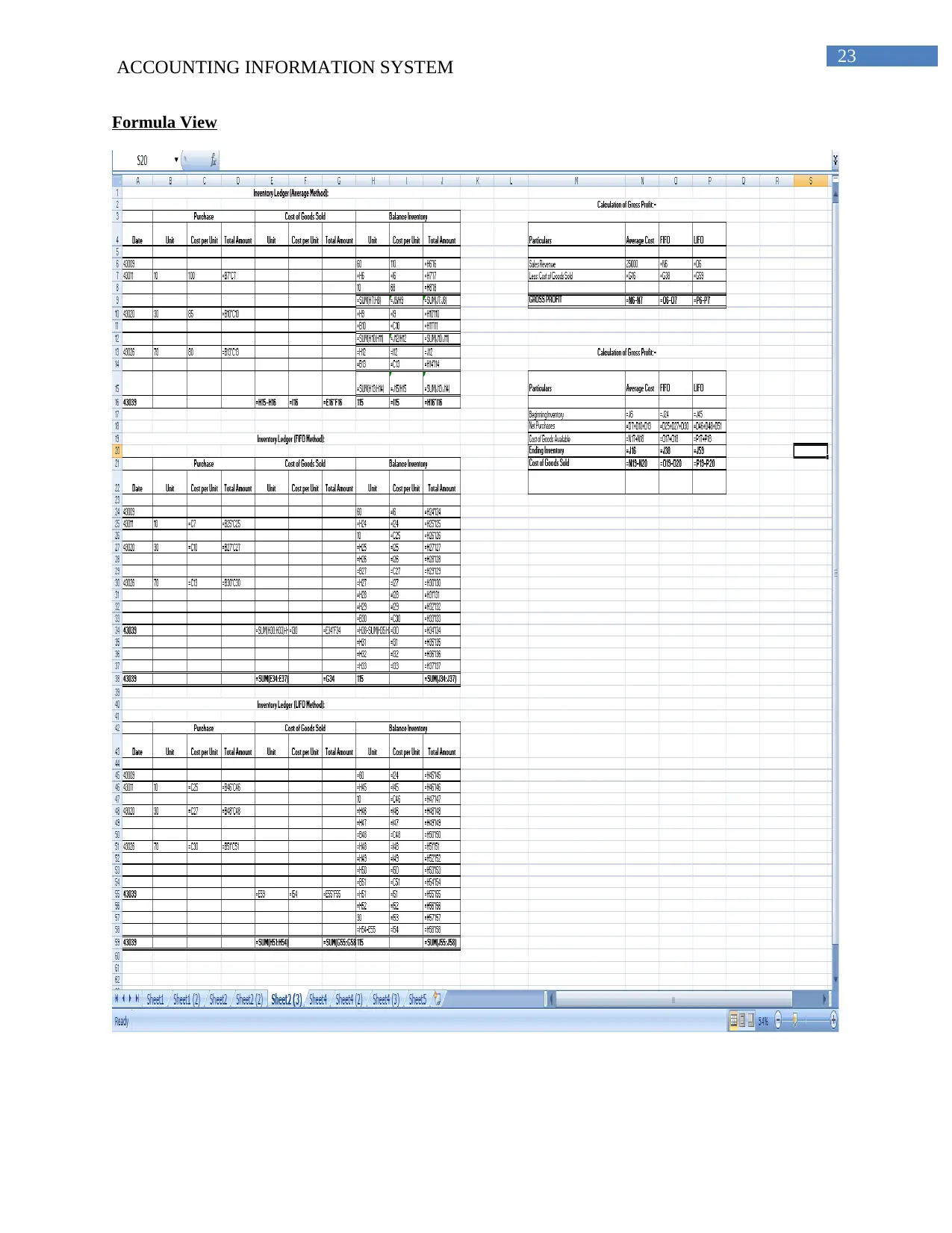
23
ACCOUNTING INFORMATION SYSTEM
Formula View
ACCOUNTING INFORMATION SYSTEM
Formula View
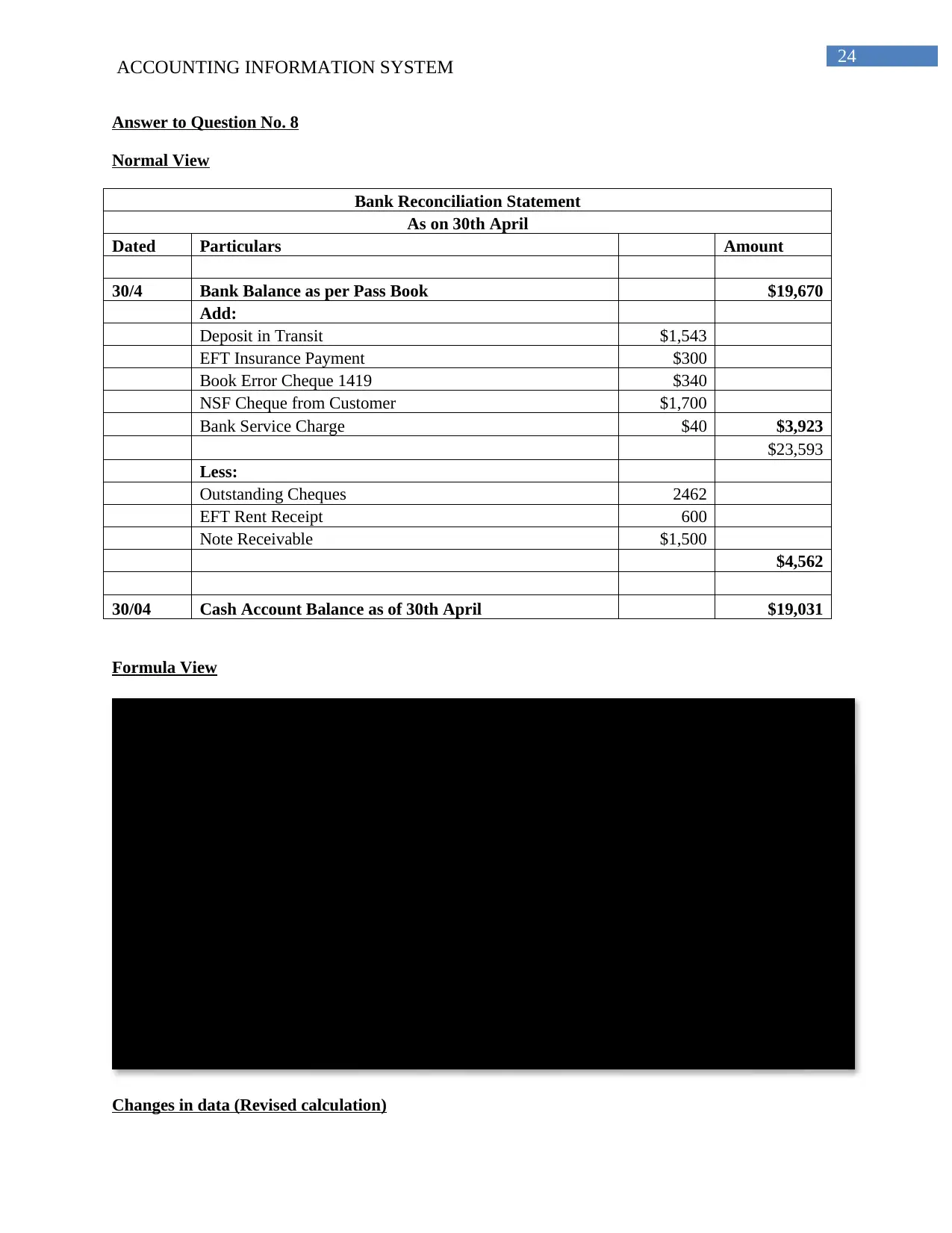
24
ACCOUNTING INFORMATION SYSTEM
Answer to Question No. 8
Normal View
Bank Reconciliation Statement
As on 30th April
Dated Particulars Amount
30/4 Bank Balance as per Pass Book $19,670
Add:
Deposit in Transit $1,543
EFT Insurance Payment $300
Book Error Cheque 1419 $340
NSF Cheque from Customer $1,700
Bank Service Charge $40 $3,923
$23,593
Less:
Outstanding Cheques 2462
EFT Rent Receipt 600
Note Receivable $1,500
$4,562
30/04 Cash Account Balance as of 30th April $19,031
Formula View
Changes in data (Revised calculation)
Date Particulars Amount
30/4 Bank Balance as per Pass Book 19670
Add:
Deposit in Transit 1543
EFT Insurance Payment 300
Book Error Cheque 1419 340
NSF Cheque from Customer 1700
Bank Service Charge 40 =SUM(D8:D12)
=E6+E12
Less:
Outstanding Cheques =1532+700+230
EFT Rent Receipt 600
Note Receivable 1500
=SUM(D15:D18)
30/04 =IF(E20>0,"Cash Account Balance as of 30th April","Bank Overdraft Balance as of 30th April") =E13-E18
Bank Reconcilaition Statement
As on 30th April
ACCOUNTING INFORMATION SYSTEM
Answer to Question No. 8
Normal View
Bank Reconciliation Statement
As on 30th April
Dated Particulars Amount
30/4 Bank Balance as per Pass Book $19,670
Add:
Deposit in Transit $1,543
EFT Insurance Payment $300
Book Error Cheque 1419 $340
NSF Cheque from Customer $1,700
Bank Service Charge $40 $3,923
$23,593
Less:
Outstanding Cheques 2462
EFT Rent Receipt 600
Note Receivable $1,500
$4,562
30/04 Cash Account Balance as of 30th April $19,031
Formula View
Changes in data (Revised calculation)
Date Particulars Amount
30/4 Bank Balance as per Pass Book 19670
Add:
Deposit in Transit 1543
EFT Insurance Payment 300
Book Error Cheque 1419 340
NSF Cheque from Customer 1700
Bank Service Charge 40 =SUM(D8:D12)
=E6+E12
Less:
Outstanding Cheques =1532+700+230
EFT Rent Receipt 600
Note Receivable 1500
=SUM(D15:D18)
30/04 =IF(E20>0,"Cash Account Balance as of 30th April","Bank Overdraft Balance as of 30th April") =E13-E18
Bank Reconcilaition Statement
As on 30th April
Paraphrase This Document
Need a fresh take? Get an instant paraphrase of this document with our AI Paraphraser
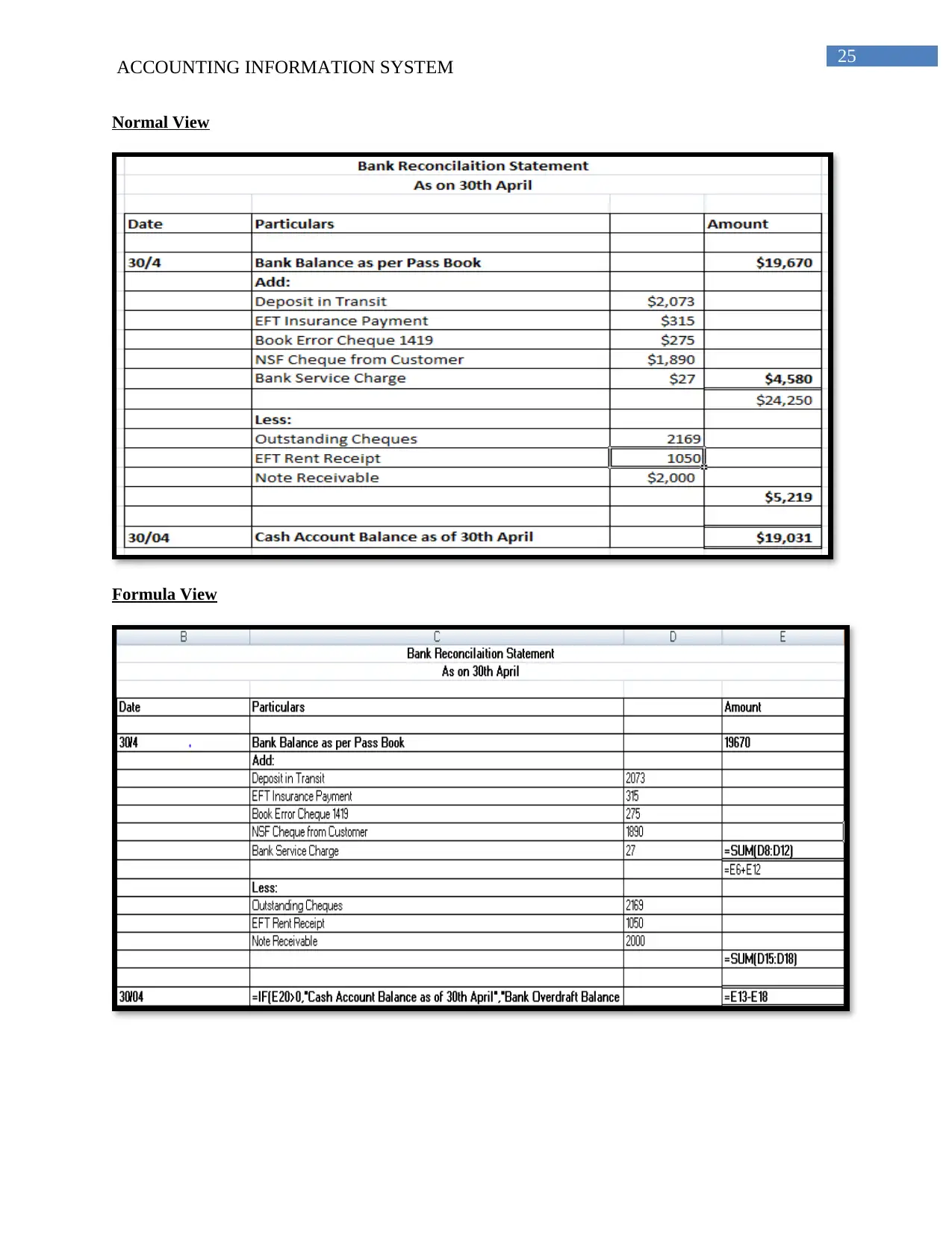
25
ACCOUNTING INFORMATION SYSTEM
Normal View
Formula View
ACCOUNTING INFORMATION SYSTEM
Normal View
Formula View
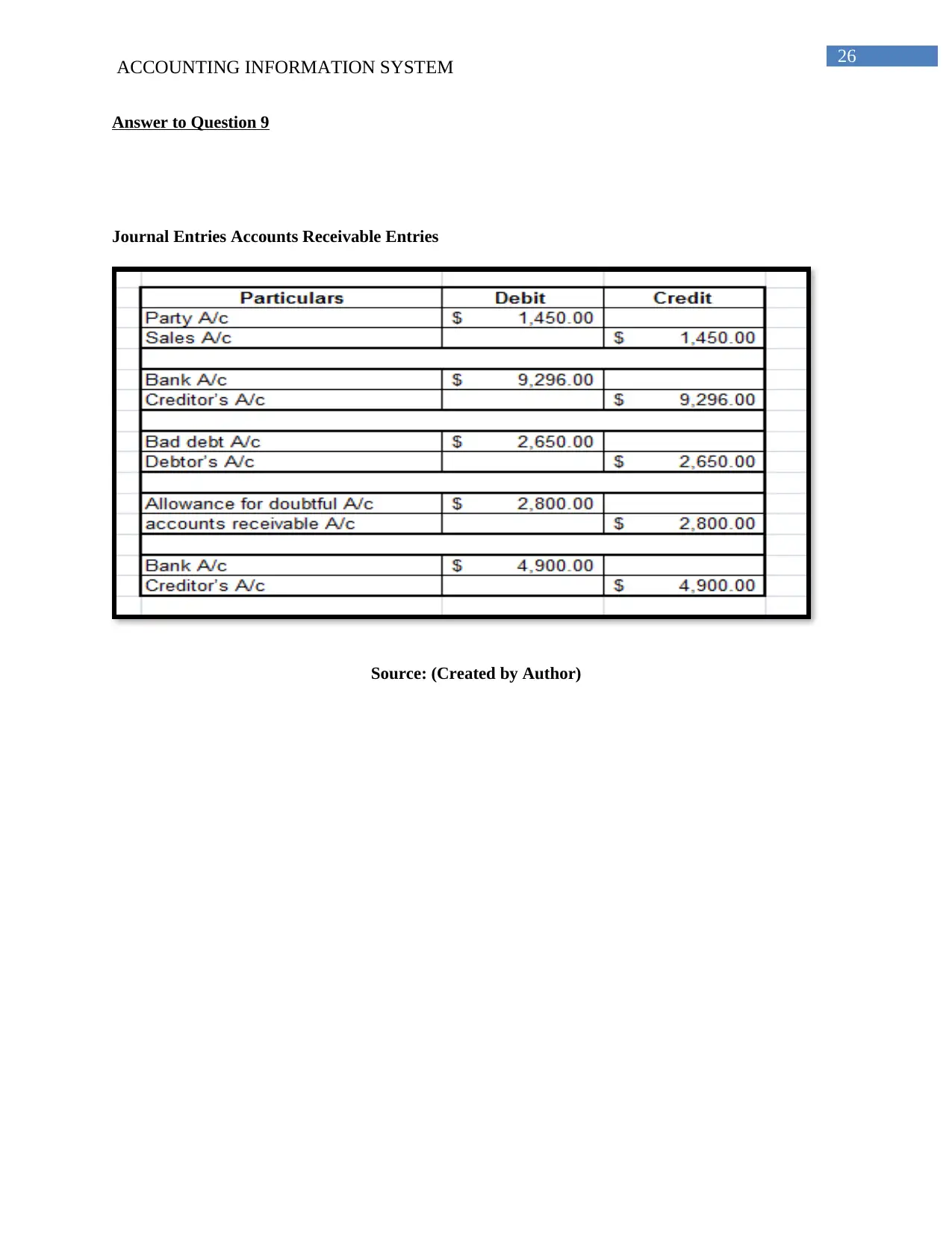
26
ACCOUNTING INFORMATION SYSTEM
Answer to Question 9
Journal Entries Accounts Receivable Entries
Source: (Created by Author)
ACCOUNTING INFORMATION SYSTEM
Answer to Question 9
Journal Entries Accounts Receivable Entries
Source: (Created by Author)
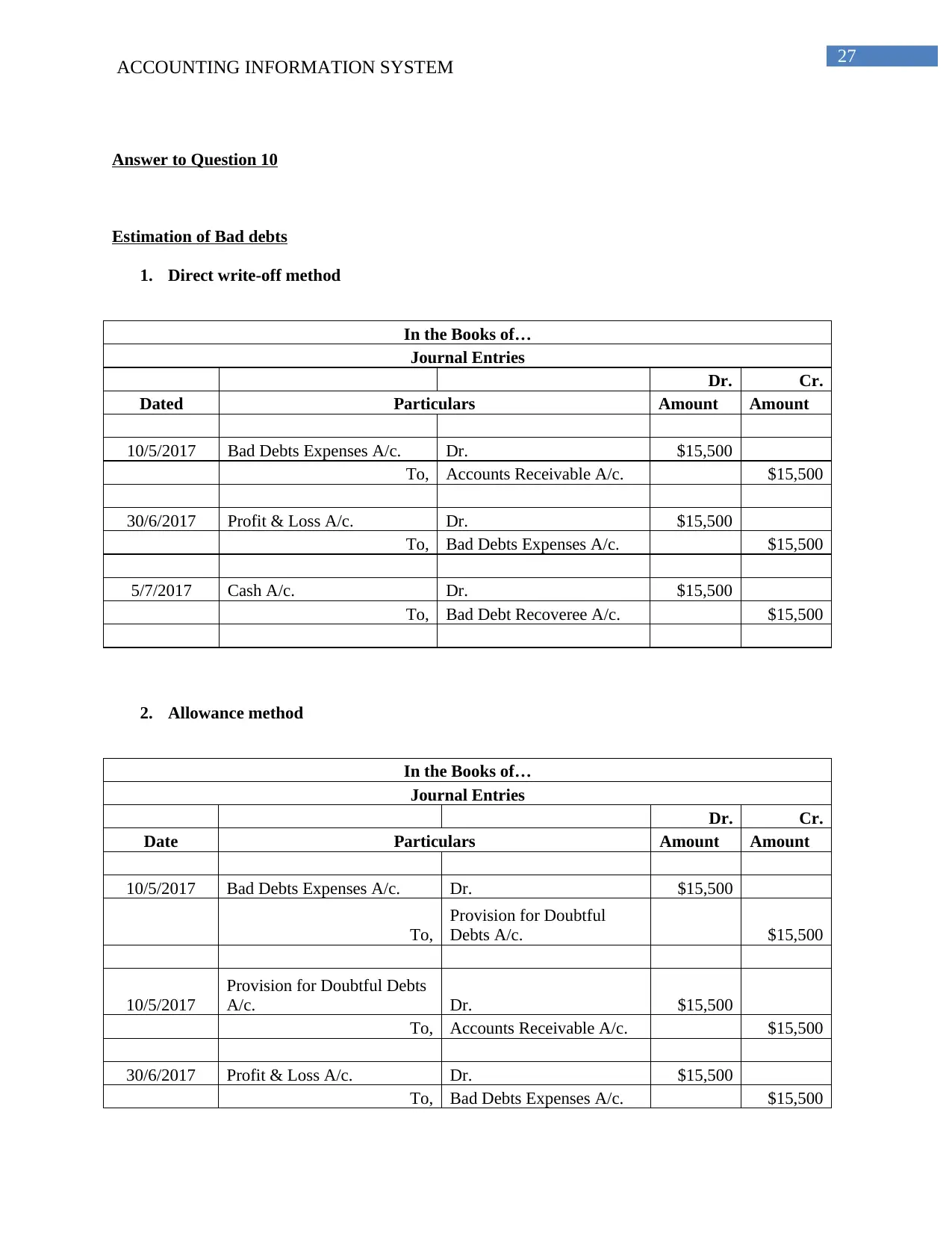
27
ACCOUNTING INFORMATION SYSTEM
Answer to Question 10
Estimation of Bad debts
1. Direct write-off method
In the Books of…
Journal Entries
Dr. Cr.
Dated Particulars Amount Amount
10/5/2017 Bad Debts Expenses A/c. Dr. $15,500
To, Accounts Receivable A/c. $15,500
30/6/2017 Profit & Loss A/c. Dr. $15,500
To, Bad Debts Expenses A/c. $15,500
5/7/2017 Cash A/c. Dr. $15,500
To, Bad Debt Recoveree A/c. $15,500
2. Allowance method
In the Books of…
Journal Entries
Dr. Cr.
Date Particulars Amount Amount
10/5/2017 Bad Debts Expenses A/c. Dr. $15,500
To,
Provision for Doubtful
Debts A/c. $15,500
10/5/2017
Provision for Doubtful Debts
A/c. Dr. $15,500
To, Accounts Receivable A/c. $15,500
30/6/2017 Profit & Loss A/c. Dr. $15,500
To, Bad Debts Expenses A/c. $15,500
ACCOUNTING INFORMATION SYSTEM
Answer to Question 10
Estimation of Bad debts
1. Direct write-off method
In the Books of…
Journal Entries
Dr. Cr.
Dated Particulars Amount Amount
10/5/2017 Bad Debts Expenses A/c. Dr. $15,500
To, Accounts Receivable A/c. $15,500
30/6/2017 Profit & Loss A/c. Dr. $15,500
To, Bad Debts Expenses A/c. $15,500
5/7/2017 Cash A/c. Dr. $15,500
To, Bad Debt Recoveree A/c. $15,500
2. Allowance method
In the Books of…
Journal Entries
Dr. Cr.
Date Particulars Amount Amount
10/5/2017 Bad Debts Expenses A/c. Dr. $15,500
To,
Provision for Doubtful
Debts A/c. $15,500
10/5/2017
Provision for Doubtful Debts
A/c. Dr. $15,500
To, Accounts Receivable A/c. $15,500
30/6/2017 Profit & Loss A/c. Dr. $15,500
To, Bad Debts Expenses A/c. $15,500
Secure Best Marks with AI Grader
Need help grading? Try our AI Grader for instant feedback on your assignments.
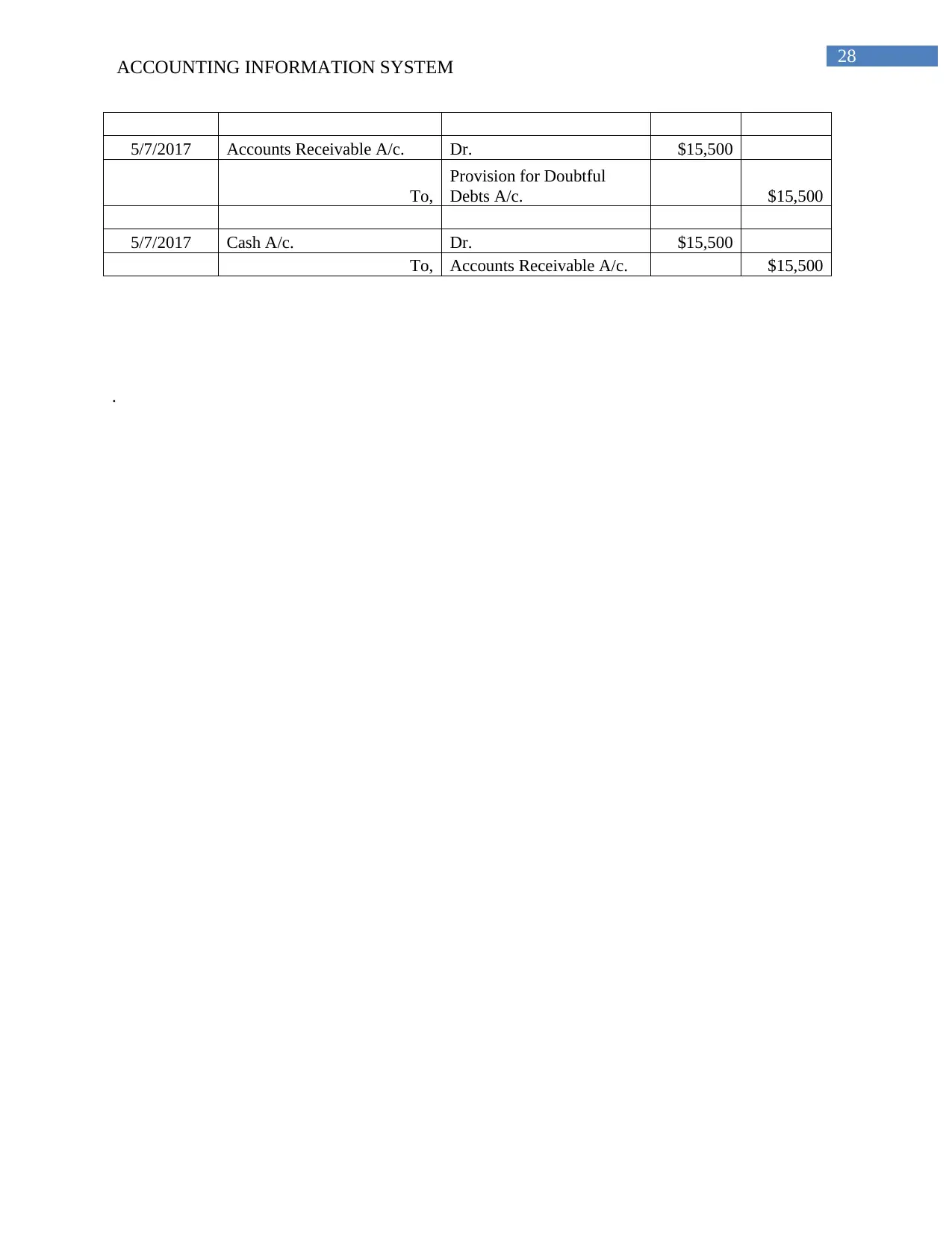
28
ACCOUNTING INFORMATION SYSTEM
5/7/2017 Accounts Receivable A/c. Dr. $15,500
To,
Provision for Doubtful
Debts A/c. $15,500
5/7/2017 Cash A/c. Dr. $15,500
To, Accounts Receivable A/c. $15,500
.
ACCOUNTING INFORMATION SYSTEM
5/7/2017 Accounts Receivable A/c. Dr. $15,500
To,
Provision for Doubtful
Debts A/c. $15,500
5/7/2017 Cash A/c. Dr. $15,500
To, Accounts Receivable A/c. $15,500
.
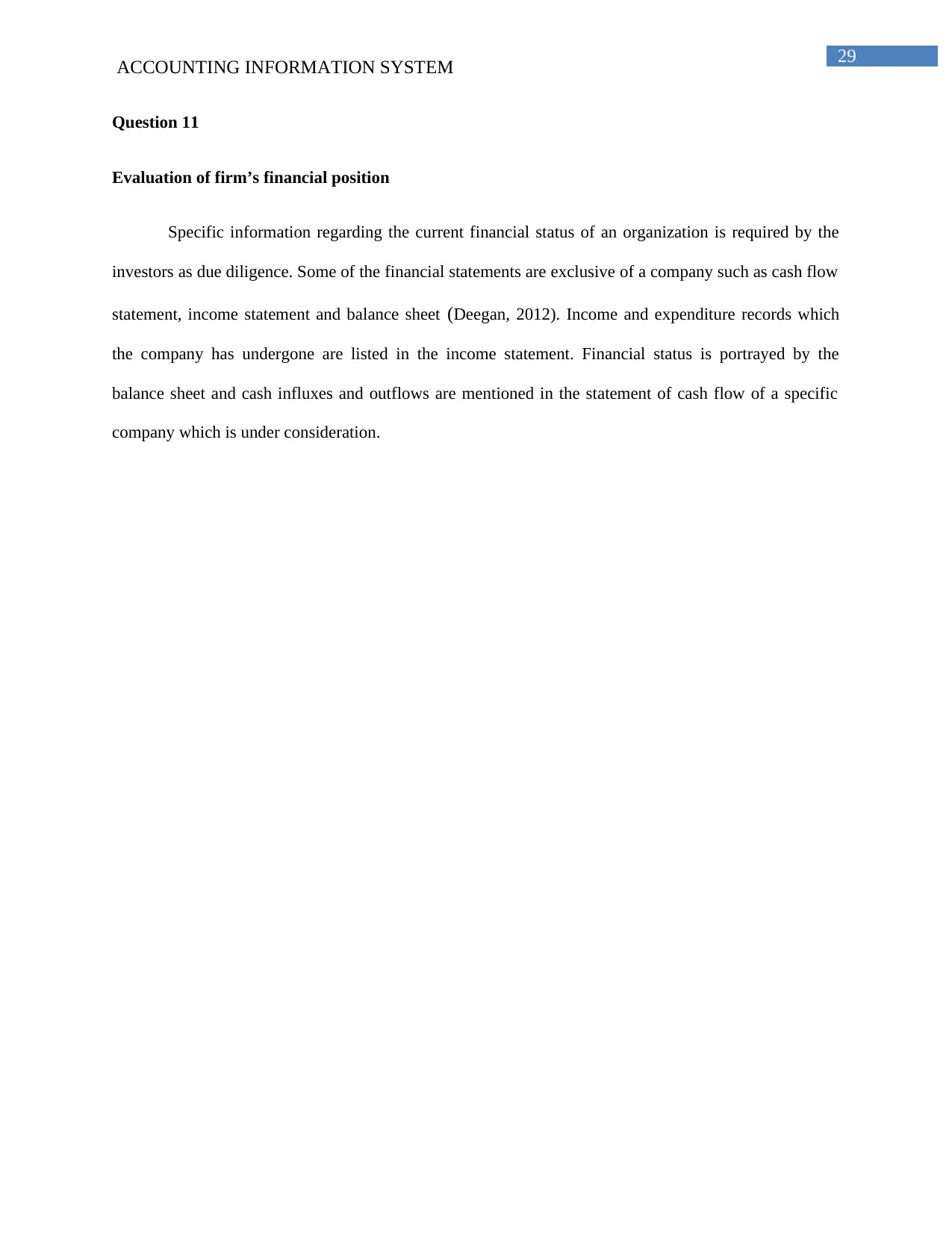
29
ACCOUNTING INFORMATION SYSTEM
Question 11
Evaluation of firm’s financial position
Specific information regarding the current financial status of an organization is required by the
investors as due diligence. Some of the financial statements are exclusive of a company such as cash flow
statement, income statement and balance sheet (Deegan, 2012). Income and expenditure records which
the company has undergone are listed in the income statement. Financial status is portrayed by the
balance sheet and cash influxes and outflows are mentioned in the statement of cash flow of a specific
company which is under consideration.
ACCOUNTING INFORMATION SYSTEM
Question 11
Evaluation of firm’s financial position
Specific information regarding the current financial status of an organization is required by the
investors as due diligence. Some of the financial statements are exclusive of a company such as cash flow
statement, income statement and balance sheet (Deegan, 2012). Income and expenditure records which
the company has undergone are listed in the income statement. Financial status is portrayed by the
balance sheet and cash influxes and outflows are mentioned in the statement of cash flow of a specific
company which is under consideration.
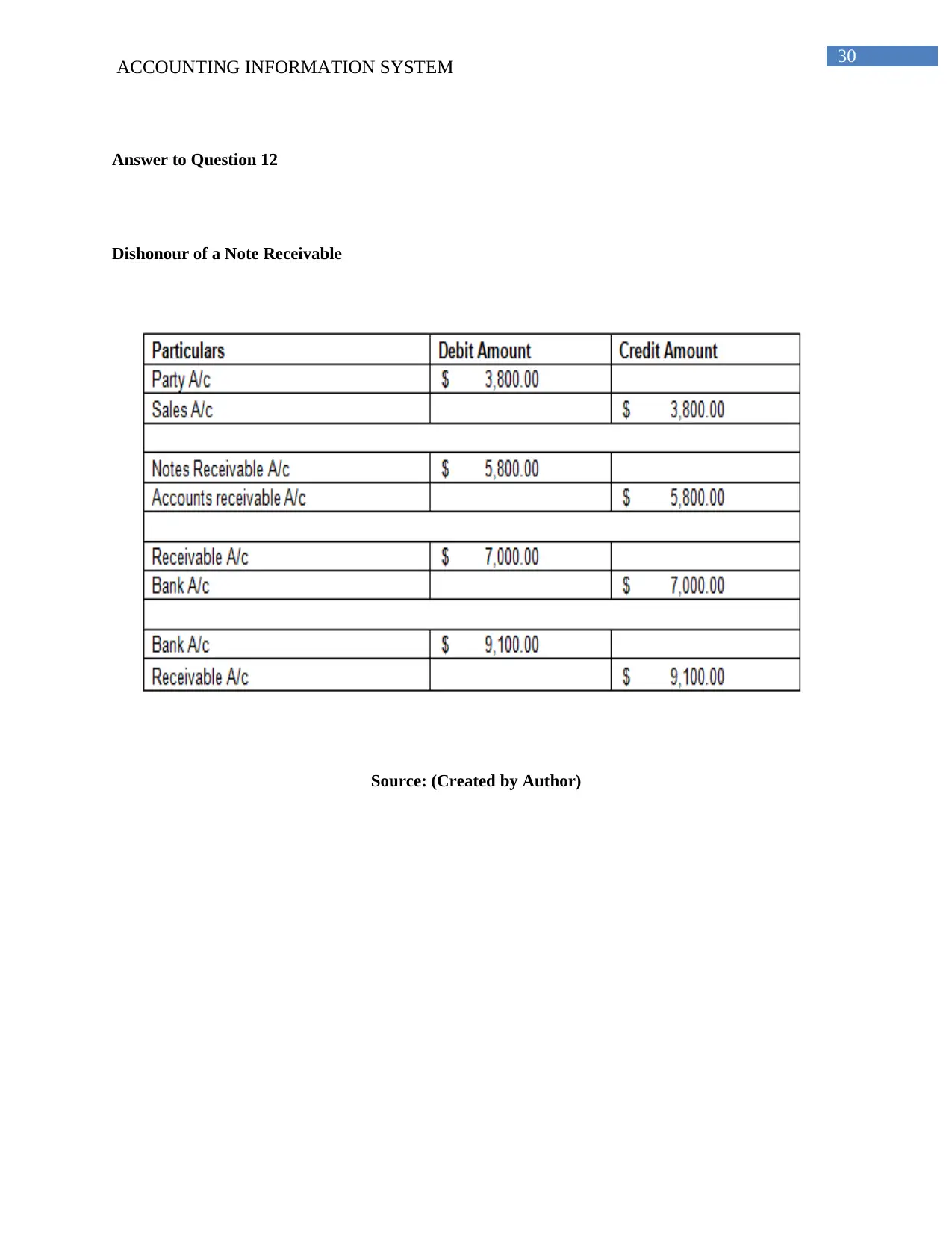
30
ACCOUNTING INFORMATION SYSTEM
Answer to Question 12
Dishonour of a Note Receivable
Source: (Created by Author)
ACCOUNTING INFORMATION SYSTEM
Answer to Question 12
Dishonour of a Note Receivable
Source: (Created by Author)
Paraphrase This Document
Need a fresh take? Get an instant paraphrase of this document with our AI Paraphraser
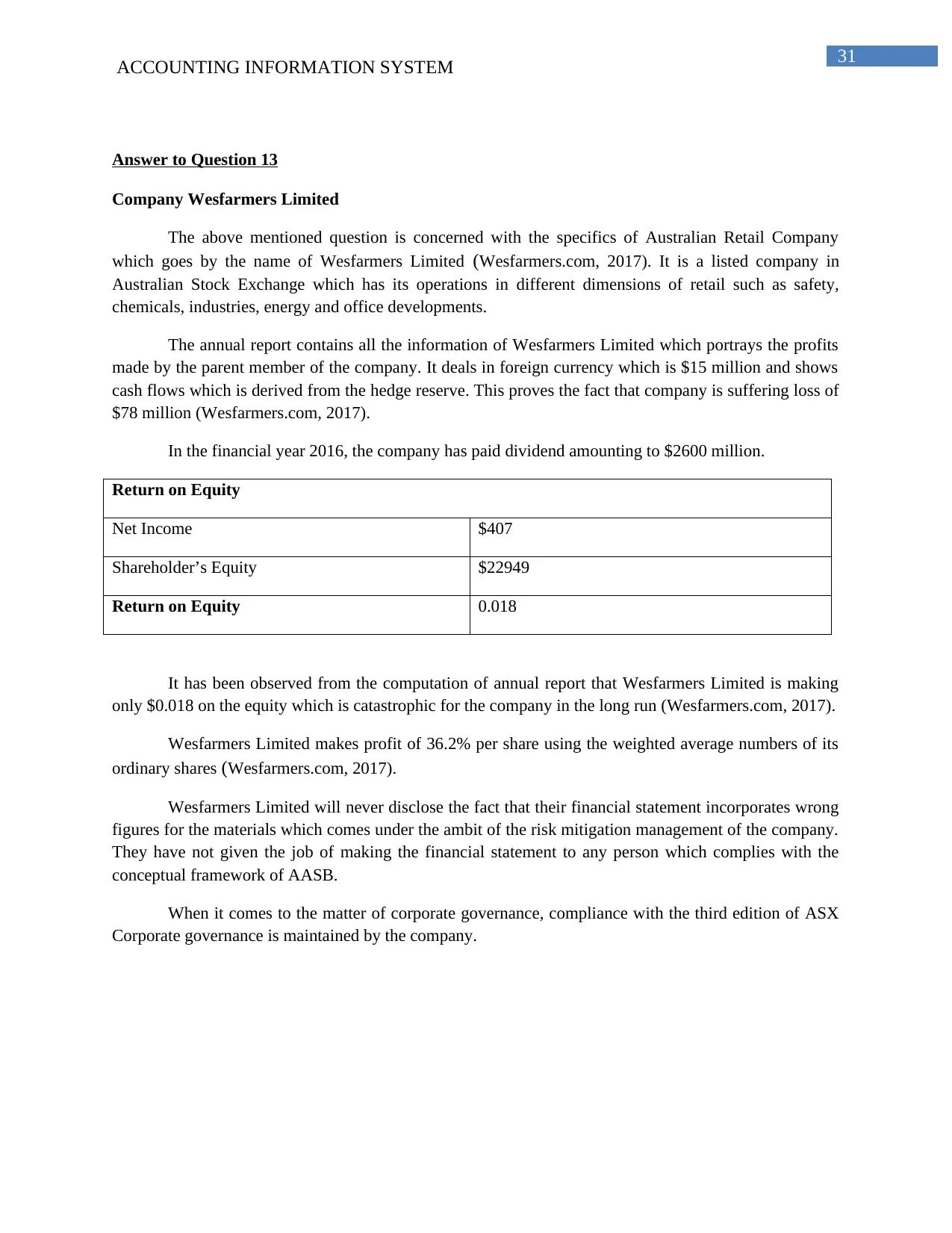
31
ACCOUNTING INFORMATION SYSTEM
Answer to Question 13
Company Wesfarmers Limited
The above mentioned question is concerned with the specifics of Australian Retail Company
which goes by the name of Wesfarmers Limited (Wesfarmers.com, 2017). It is a listed company in
Australian Stock Exchange which has its operations in different dimensions of retail such as safety,
chemicals, industries, energy and office developments.
The annual report contains all the information of Wesfarmers Limited which portrays the profits
made by the parent member of the company. It deals in foreign currency which is $15 million and shows
cash flows which is derived from the hedge reserve. This proves the fact that company is suffering loss of
$78 million (Wesfarmers.com, 2017).
In the financial year 2016, the company has paid dividend amounting to $2600 million.
Return on Equity
Net Income $407
Shareholder’s Equity $22949
Return on Equity 0.018
It has been observed from the computation of annual report that Wesfarmers Limited is making
only $0.018 on the equity which is catastrophic for the company in the long run (Wesfarmers.com, 2017).
Wesfarmers Limited makes profit of 36.2% per share using the weighted average numbers of its
ordinary shares (Wesfarmers.com, 2017).
Wesfarmers Limited will never disclose the fact that their financial statement incorporates wrong
figures for the materials which comes under the ambit of the risk mitigation management of the company.
They have not given the job of making the financial statement to any person which complies with the
conceptual framework of AASB.
When it comes to the matter of corporate governance, compliance with the third edition of ASX
Corporate governance is maintained by the company.
ACCOUNTING INFORMATION SYSTEM
Answer to Question 13
Company Wesfarmers Limited
The above mentioned question is concerned with the specifics of Australian Retail Company
which goes by the name of Wesfarmers Limited (Wesfarmers.com, 2017). It is a listed company in
Australian Stock Exchange which has its operations in different dimensions of retail such as safety,
chemicals, industries, energy and office developments.
The annual report contains all the information of Wesfarmers Limited which portrays the profits
made by the parent member of the company. It deals in foreign currency which is $15 million and shows
cash flows which is derived from the hedge reserve. This proves the fact that company is suffering loss of
$78 million (Wesfarmers.com, 2017).
In the financial year 2016, the company has paid dividend amounting to $2600 million.
Return on Equity
Net Income $407
Shareholder’s Equity $22949
Return on Equity 0.018
It has been observed from the computation of annual report that Wesfarmers Limited is making
only $0.018 on the equity which is catastrophic for the company in the long run (Wesfarmers.com, 2017).
Wesfarmers Limited makes profit of 36.2% per share using the weighted average numbers of its
ordinary shares (Wesfarmers.com, 2017).
Wesfarmers Limited will never disclose the fact that their financial statement incorporates wrong
figures for the materials which comes under the ambit of the risk mitigation management of the company.
They have not given the job of making the financial statement to any person which complies with the
conceptual framework of AASB.
When it comes to the matter of corporate governance, compliance with the third edition of ASX
Corporate governance is maintained by the company.
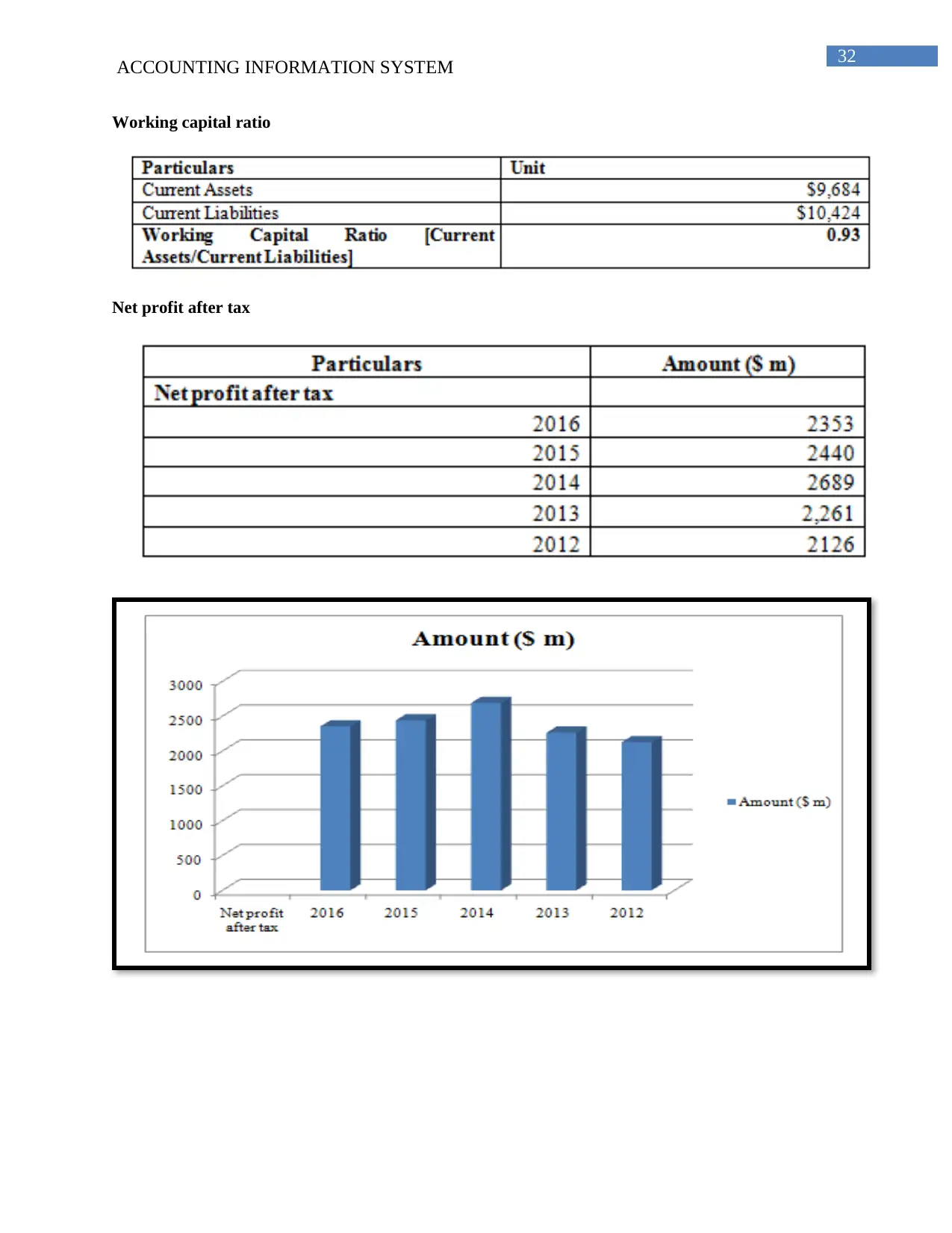
32
ACCOUNTING INFORMATION SYSTEM
Working capital ratio
Net profit after tax
ACCOUNTING INFORMATION SYSTEM
Working capital ratio
Net profit after tax
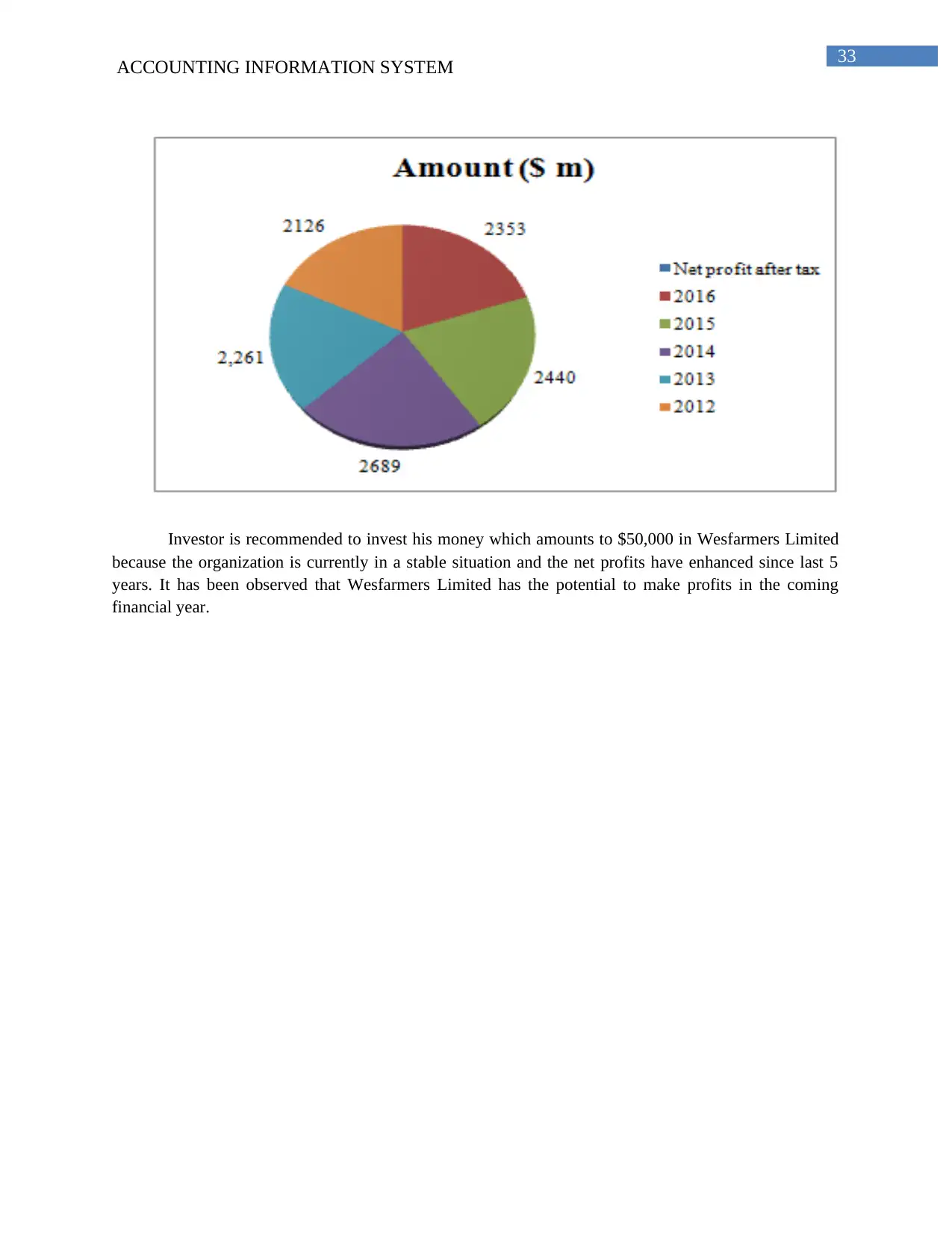
33
ACCOUNTING INFORMATION SYSTEM
Investor is recommended to invest his money which amounts to $50,000 in Wesfarmers Limited
because the organization is currently in a stable situation and the net profits have enhanced since last 5
years. It has been observed that Wesfarmers Limited has the potential to make profits in the coming
financial year.
ACCOUNTING INFORMATION SYSTEM
Investor is recommended to invest his money which amounts to $50,000 in Wesfarmers Limited
because the organization is currently in a stable situation and the net profits have enhanced since last 5
years. It has been observed that Wesfarmers Limited has the potential to make profits in the coming
financial year.
1 out of 34
Related Documents
Your All-in-One AI-Powered Toolkit for Academic Success.
+13062052269
info@desklib.com
Available 24*7 on WhatsApp / Email
![[object Object]](/_next/static/media/star-bottom.7253800d.svg)
Unlock your academic potential
© 2024 | Zucol Services PVT LTD | All rights reserved.





